Fantasy Books
Spotlight on “The Antidote” by Karen Russell
The Antidote is a gripping dust bowl epic about five characters whose fates become entangled…
The post Spotlight on “The Antidote” by Karen Russell appeared first on LitStack.
On McPig's Radar - A Web of Obsidian
 A Web of Obsidian(The Obsidian Sisterhood #1)by Lydia M. Hawke
A Web of Obsidian(The Obsidian Sisterhood #1)by Lydia M. HawkeAt 69 years old and with two martial arts black belts to her name, Sister Monica Barrett has never been one to back down from a fight. But the one that just landed on the ragged front lawn of the women’s shelter she runs may be more than she’s equipped to handle.
At first glance, the assailant in pursuit of a young woman seems like an all-too-familiar story. But this attacker has powers—he moves with uncanny speed, strikes with brutal accuracy, and isn’t after the woman at all. Instead, he wants what she has: a flat, black stone with a spider’s web embedded in it.
The instant Monica touches the stone, her world is turned upside down. Power surges through her and destroys her adversary—the kind of supernatural power that should belong only to the God she serves. A horrified Monica is determined to rid herself of the stone and whatever it holds, but with more attackers coming after her and the women she shelters, she needs to move fast.
Can Monica find where the stone came from before it falls into the wrong hands? Will it be safe to return it to its rightful place? Or has a nun of a certain age just inadvertently become the keeper of a dark power no human should wield?
Expected publication February 25, 2025
Track Her Down by Melinda Leigh
Mystery
When Claire returns home from work she discovers her parents, lying in bed, murdered. While investigating the murder Bree Taggert uncovers family secrets and a shocking motive.
Every now and then an author stumbles upon the magic sauce that makes a series great. Robyn Carr found it with Virgin River, Patricia Briggs with Mercy Thompson and Kendra Elliot nailed it with Mercy Kilpatrick. Bree Taggert is kind of like that. Melinda Leigh’s other series’ were good, even great, but Bree Taggert got everything right.
And when you hit that sweet spot there is a lot of pressure to keep going. Robyn Carr kept going with Virgin River way past its best before date. I wonder if Patricia Briggs is also approaching that point with Mercy Thompson. And in some ways this book feels like that. It’s good. Every bit as good as some of her other books, but it also feels like maybe the series has run its course and maybe it’s time to explore new ideas.
Overall, this book was good but not great. But there were opportunities in this book which were not explored and I hope Melinda Leigh planted those seeds to be explored in her next project.

Review: The Devils by Joe Abercrombie

Buy The Devils
OFFICIAL AUTHOR BIO: Joe Abercrombie was born in Lancaster, England, studied psychology at Manchester University, and worked as an editor of documentaries and live music before his first book, The Blade Itself, was published in 2006. Two further installments of the First Law trilogy, Before They Are Hanged and Last Argument of Kings, followed, along with three standalone books set in the same world: Best Served Cold, The Heroes, and Red Country. He has also written the Shattered Sea trilogy for young adults, the Age of Madness trilogy for old adults, and Sharp Ends, a collection of short stories. He lives in Bath, England, with his wife and three children. The Devils is his thirteenth novel.FORMAT/INFO: The Devils will be released by Tor Books on May 6th, 2025. It is 560 pages. It will be released in hardcover, ebook, and audiobook formats.
OVERVIEW/ANALYSIS: When Brother Diaz is summoned to the Sacred City, he's sure he is finally landing a prestigious position that will reflect his hard work and dedication. But instead of a noble, glorious assignment, he finds himself in charge of the Chapel of Holy Expediency, an arm of the wing the Church doesn't even officially acknowledge. Brother Diaz is now responsible for dangerous individuals, ranging from a blood-thirsty werewolf to an arrogant necromancer. Their current assignment: escort a lost princess across the continent and install her as the rightful empress of a neighboring empire. In their way: four dangerous cousins who want the princess eliminated so they can take the throne instead.
The Devils is another fantastic fantasy novel featuring that signature blend of Abercrombie: violence, crassness, and a host of memorable characters. Unsurprisingly, my favorite part of the story was the characters themselves. There are several POVs in this book, and every chapter felt like it had a distinctive voice. You could tell when it was a princess chapter versus a werewolf chapter versus a necromancer chapter. All these POV chapters provide insights into the characters themselves, which allows the readers to grapple with a real question: How dangerous are the members of the Chapel of Holy Expediency? Are they being unnecessarily prosecuted? Or has the Church accurately determined that these people are a clear and present danger to society if left unchecked? There is not a cookie cutter answer that applies to all of these characters, and it was intriguing to unpick their backstories and make my own judgement about them.
Speaking of the Church, let’s discuss the setting itself. The Devls is set in an alternate medieval Europe; while you’ll find references to familiar locations like England and Barcelona, you’ll also find the populace lives in fear of another invasion of cannibalistic elves. The Church is Christianity-adjacent, in that it worships one God, but they use different iconography, and their Savior is a woman, resulting in much of the upper Church leadership being women. All of this is in service of a VERY thinly veiled satirical critique of organized religion. It is a constant theme throughout the book, to the point of being slightly overdone.
The story itself was a blast to read. Our characters must journey from essentially the Vatican to Troy to return the lost princess to her throne. In their way are four royal cousins who want the throne for themselves, resulting in multiple attacks, traps, and attempts on the princess’s life. While individually, each fight is well done and distinctive, it did start to feel slightly repetitive by the end of this 500+ page book.
CONCLUSION: That doesn’t stop The Devils from having one heck of a gut punch as the story concludes. While the mission of this particular book, returning the princess to her throne, is wrapped up by the end, there are multiple tantalizing hooks dangling that foreshadow things to come. I myself cannot wait to see these characters come back and grapple with a new problem, and see how events from book one have (or haven’t changed) their outlooks. In short, The Devils is a fantastic opening for a trilogy that is sure to be thrilling and engaging journey.
Cover Reveal: Special Delivery by Rex Burke

OFFICIAL BOOK BLURB: A dangerous mission. A second chance.
Actually, scratch that. No chance.Dix’s career as a trooper in the Federation army is unblemished – until the day he disobeys a direct order and strikes an officer.
Now Dix has a choice. Face a life of hard labour that promises to be brutal and short. Or accept a mysterious invitation to join a black-ops mission in hostile terrain.
The plan sounds simple, if horribly dangerous. Fetch a fearsome weapon from a secret location and deliver it to a distant planet, whose population is under the chilling yoke of the Federation’s rival empire, the Axis. Do it without getting caught, or implicating the Federation, and Dix’s transgressions will be forgiven.
But the weapon turns out to be unlike anything he could have expected, and Dix’s troubles have only just begun.
'SAS Rogue Heroes' x 'Starship Troopers' – Special Delivery introduces a ragtag crew of misfits and malcontents on a mission with more holes than a blaster-riddled corpse. It’s a fluid, easy-reading, military-action Sci-Fi adventure, perfect for fans of Tanya Huff and John Scalzi.
Intriguing? Let's look at the cover, designed by: Chris Hudson

PREORDER your copy of Special Delivery here
OFFICIAL AUTHOR INFORMATION: Rex Burke is a SciFi writer based in North Yorkshire, UK.
When he was young, he read every one of those yellow-jacketed Victor Gollancz hardbacks in his local library. He’s sure there are still thrilling SciFi adventures to be told – even if he has to write them himself.
When he’s not writing, he travels – one way or another, he’ll get to the stars, even if it’s just as stardust when his own story is done.
Website: https://rexburke.com/
Contact: rex@rexburke.com
BlueSky: @rexburke.bsky.social
Let's hear from the author about how he came up with the idea from the book:
"Ideas for books come to me in all sorts of ways – the first germ of what became Orphan Planet was a disastrous camping trip one of my sons went on; The Wrong Stop came out of a lifetime spent travelling around Europe on trains, and wondering about the people I met on board.And sometimes a single thought is enough, and on one such train, early last year, two fully formed sentences popped into my head, unbidden. Here they are:
†'Their unit, OneSquad, had been fighting hard all day across difficult terrain. The planet was a squelching, crater-filled shithole, and Dix was covered in mud – at least, he hoped it was mud – but orders were orders.'
Those two sentences begin the book that is Special Delivery, which will be published in April.
I never set out to write a hard-edged Sci-Fi story about space troopers on a secret mission, but that's what my next book is – though you should be reassured that it's also full of banter, laughs, scrapes and mysteries. A traditional Rex Burke book, in fact, but this time set entirely in space, and with added fights, guns, blood, intrigue and betrayal."
7 Author Shoutouts | Authors We Love To Recommend
Here are 7 Author Shoutouts for this week. Find your favorite author or discover an…
The post 7 Author Shoutouts | Authors We Love To Recommend appeared first on LitStack.
Reading for the End of the World Redux
Eight years ago, in the wake of the 2016 election, I penned a piece for Black Gate that I called “Reading for the End of the World”, in which I listed a dozen books I thought ideal for helping us get through the four years of turmoil and uncertainty that loomed ahead. I wrote it, posted it, and moved on with my life, little suspecting that coping with that particular cultural earthquake was not a one-time job like getting a vasectomy, but would instead turn out to be an onerous recurring chore like mowing the lawn or doing the laundry.
Well, if He did it again, I suppose I should too. Therefore, once again, “In the spirit of the incipient panic, withered expectations, and rampant paranoia that seem to dominate our current national life, I offer twelve books to get you through the next four years (however long they may actually last): a reading list for the New Normal.” (Groundhog Day is a movie, not a book; that’s why it’s not here.) In 2017 I hoped that the books I discussed would provide some much-needed insight or diversion, and that’s my hope for these twelve additional volumes. Some things have changed after the passage of eight years, however, so now I suppose I should also state that these books were neither written nor selected with the help of A.I. (Of course, that just begs the larger question — how do you know that “Thomas Parker” is a real person? Short answer: you don’t. Then again, I don’t know if any of you are real people, either.)
1. All the King’s Men by Robert Penn Warren, 1946
Generally considered the greatest American political novel (though Robert Penn Warren denied that he had any explicit political intent in writing it), All the King’s Men follows the rise and fall of Willie Stark, who begins as an idealistic backcountry lawyer and ends as the extraordinarily powerful and ruthless governor of his state. That state is Louisiana, and Willie Stark bears more than a coincidental resemblance to the real-life governor of Louisiana from 1928 to 1932, Huey Long, who maintained an iron grip on the state even after he left the Baton Rouge statehouse to become a United States Senator and presidential aspirant. Long’s career ended with his assassination in 1935, just as Willie Stark’s life is also cut short by an assassin’s bullet. However, the book is more than just a political roman à clef, more than an incisive portrait of an unscrupulous demagogue or a warning about the dangers such a person can pose for a democracy; fundamentally, it’s meditation on the mysterious conjunctions of character and history, and an examination of the myriad ways personal (and often petty) passions mesh in unforeseen and unpredictable ways, powering the huge, seemingly impersonal processes we all find ourselves caught up in. All the King’s Men (which has been filmed twice, first in 1949, winning Broderick Crawford a Best Actor Oscar for his Category 5 portrayal of Willie Stark, and less successfully in 2006, this time with Sean Penn in the lead role) is a book which will always have something to say to those who want to gain some measure of understanding (if not tranquility) by taking a step back and viewing the storm from a distance.
2. Stayin’ Alive: The 1970’s and the Last Days of the Working Class by Jefferson Cowie, 2010
Stayin’ Alive (the irony of the title becomes increasingly apparent through the course of the book) sheds a bright light on our current condition by chronicling how “The social and political spaces for the collective concerns of working people — the majority of the citizenry — disappeared from American civic life when the nation moved from manufacturing to finance, from troubled hope to jaded ennui, from the compromises and constraints of industrial pluralism to the jungle of the marketplace.” The progression of the key players — labor leaders like Jimmy Hoffa and George Meany and politicians like Hubert Humphrey, Robert and Edward Kennedy, Richard Nixon, George McGovern, George Wallace, Jimmy Carter, and Ronald Reagan — illustrates the shift from a working class that defined itself by its material conditions (wages, benefits, working conditions, freedom to unionize) to one that defined itself by positions on so-called “cultural” issues (busing, abortion, “patriotism” loosely defined.) Cowie also has time to look at television, movies and music, from Bruce Springsteen’s album Born to Run, with its message that working class life can’t be transformed but only escaped, to the film Dog Day Afternoon, which says that even escape is impossible. The book’s analysis is brilliant and persuasive, and though Cowie tries to hold out some hope for the future, the picture painted is a bleak one, depicting as it does a landscape of diminished economic opportunity, truncated rights, and withered hope — pretty much the world we live in today, which is a direct result of the 70’s, a decade by the end of which “working people would possess less place and meaningful identity within civic life than at any time since the industrial revolution.”
 3.Singular Travels, Campaigns and Adventures of Baron Munchausen by R.E. Raspe and Others, 1948
3.Singular Travels, Campaigns and Adventures of Baron Munchausen by R.E. Raspe and Others, 1948
Think carefully before you answer — who is the greatest liar in history? You’re right, of course — it’s Baron Munchausen! In the picaresque novel by Rudolph Erich Raspe, first published in 1785, the nobleman is a nonstop raconteur, spinning stories of his adventures and exploits as a military man and world traveler. Such memoirs were fairly common in the eighteenth century, but few ex-soldiers ever (successfully!) wrestled a forty-foot crocodile, visited the moon by climbing up a beanstalk, rode a flying cannonball over enemy lines, or got swallowed by a great fish while bathing in the Mediterranean (Munchausen freed himself by dancing the hornpipe in the creature’s stomach, which caused it to thrash about and head for the surface, thus attracting the attention of a ship, which harpooned it, hauled it on board, and began cutting it up. “As soon as I perceived a glimmering of light I called out lustily to be released from a situation in which I was now almost suffocated. It is impossible for me to do justice to the degree and kind of astonishment which sat upon every countenance at hearing a human voice issue from a fish, but more so at seeing a naked man walk upright out of his body: in short, gentlemen, I told them the whole story, as I have told you, whilst amazement struck them dumb.”) The actual Baron Munchausen, who fought for Russia in various campaigns against the Turks, spent his retirement entertaining people by telling tall tales about his exploits. Raspe heard some of these yarns and put them into his book along with other outrageous lies of his own invention, which infuriated and humiliated the real Baron, who was driven into seclusion by the ridicule of all Europe. To think that sheer embarrassment could make someone retire from public life; 1785 was a long time ago, was it not? (If you want to read these wildly entertaining adventures, make sure you get an edition that has the original illustrations by Gustave Doré; they are just as funny and delightful as the Baron’s fabulations.)
4. The Iron Dream by Norman Spinrad, 1972
Alternate-history stories come in many varieties, from The Man in the High Castle to Bring the Jubilee to Pavane to Harry Turtledove’s infinitely expanding oeuvre, but few of them are as audacious and original as Norman Spinrad’s foray into the genre, The Iron Dream. The inside-cover blurb lets you know what you’re in for: “Let Adolf Hitler transport you to a far-future Earth, where only FEREC JAGGAR and his mighty weapon, the Steel Commander, stand between the remnants of true humanity and annihilation at the hands of the totally evil Dominators and the mindless mutant hordes they completely control.” That pretty much sums up the plot of the novel (which, once you get past the book’s cover, actually turns out to be titled Lord of the Swastika), and the alternate-history aspect is taken care of by an “About the Author” note at the beginning of the book and an “Afterword to the Second Edition” at the end, purportedly written in 1959 by a New York University academic named Homer Whipple. The bio tells us that after serving in the Great War and briefly dabbling in “radical politics”, Adolf Hitler emigrated to New York in 1919, where he first became a successful science fiction illustrator (for Amazing, no less) and then a science fiction writer himself, the author of such classics as Savior from Space, The Thousand Year Rule, The Master Race, and Tomorrow the World. In the afterword, Whipple chronicles Hitler’s literary career up until his death in 1953, afterwards analyzing Lord of the Swastika and finding in its fetishistic imagery the source of the book’s lasting appeal to hardcore science fiction fans, who awarded Hitler a posthumous Hugo in 1954… so what we have here is not a novel about an alternate history — it’s a novel from an alternate history. How is Lord of the Swastika? (Spinrad reportedly wanted the book to be published under that title, with only Hitler’s name on the cover, but was stymied by his publisher.) Well, based on my own reading about Der Führer (primarily the Bullock and Kershaw biographies, Speer’s memoirs, and Richard Evans’ history of the Third Reich), Spinrad is disquietingly successful at transmogrifying Hitler’s pathological obsessions and rigid, paranoid worldview into pulp science fiction, and one of the most remarkable things about the book is its uncomfortably pointed demonstration of how perfectly the themes and devices of pulp sf suit a violent, authoritarian imagination. In any case, being locked up inside Adolf’s head, even for satirical purposes, isn’t all that enjoyable, and well before the book ends, distaste begins to outweigh novelty, and you’re eager for the “author” to… well, blow his brains out. Spinrad may have been just a little too clever, and The Iron Dream might be one of those books that would be twice as effective at half the length. Still, it’s quite a ride, and I can’t think of another novel like it.
5. Spider Kiss by Harlan Ellison, 1961
Harlan Ellison was one of our best short story writers, but he produced only a few genuine novels. Among that handful, though, is one of his best works, his rock-and-roll novel Spider Kiss (which was originally published by Gold Medal — the mark of quality! — as Rockabilly). Country boy Luther Sellars has an abundance of musical ability and a limitless desire to push, claw, and gouge his way to the top, a vicious, elemental drive unmediated by any trace of scruple. After changing his name to Stag Preston, he succeeds in climbing to the pinnacle of pop music success, becoming the idol of millions. Stag’s unholy combination of ferocious ambition, demonic talent, and unbridled appetite (especially his sexual one) finally lead to his downfall, and after his scandalous excesses (which include some genuine and serious crimes) send him careening to the bottom, he ends his days playing is a sleazy strip joint, far from the big money and the bright lights, mercifully forgotten. Ellison clearly knew the great 1957 Elia Kazan film A Face in the Crowd, in which Andy Griffith excels as Larry “Lonesome” Rhodes, a folksy entertainer whose good old boy demeanor conceals a very nasty streak and who plays out a rise-and-fall story very similar to Stag’s. Stag is, if anything, even worse than Rhodes, and the book is a riveting portrait of a driven and near-sociopathic personality. Ellison later retrofitted many elements of Stag’s character and story onto his script for the 1966 film The Oscar (in which the amoral user is an actor named Frank Fane), a movie so godawful it’s divine.
6. 85 Days: The Last Campaign of Robert Kennedy by Jules Whitcover, 1969
We’ve gotten used to some wild presidential elections over the last decade and a half, but few campaigns in American history were as chaotic, divisive, and ultimately tragic as the one all the way back in 1968. When President Lyndon Johnson announced that he was not going to run for re-election, Robert Kennedy at first publicly said that he wasn’t going to seek the nomination himself, a decision that went against all of his political instincts. It galled him to leave the field to Hubert Humphrey (Johnson’s vice-president and a man likely to continue LBJ’s war policies) and the upstart anti-war candidate Eugene McCarthy, but when McCarthy’s surprising early success showed the potential strength of an anti-Vietnam War candidate, Kennedy threw his hat into the ring. A frantic campaign followed, with RFK scrambling to put together an organization, enter primaries, and make up an enormous amount of lost ground. Along the way, Kennedy earned the animus of McCarthy (for stealing his thunder — and his young, anti-war voters) and Johnson (for opposing his policies), made Kennedy history by losing one primary (Oregon), gained some momentum by winning others (South Dakota, Nebraska), and was called on to help the country weather the shock of the Martin Luther King jr. assassination, a bare eight weeks before his own death at the hands of Sirhan Sirhan on the night he won his greatest victory in California — all in eighty-five days (three weeks less than Vice President Harris had in her own truncated campaign). Whitcover’s book is a definitive account of one of the most dramatic political contests in our history, a kind of combat-photographer snapshot taken at a moment when the country seemed hurtling toward the apocalypse — and not for the last time.
7. The Last Policeman Trilogy (The Last Policeman, Countdown City, World of Trouble) by Ben H. Winters, 2012-2014
If you think things are bad now, take heart — they could be worse. The world could be ending literally rather than metaphorically; there could be a ginormous asteroid on a collision course with earth that will extinguish human civilization on impact, which is the situation faced by Hank Palace at the beginning of The Last Policeman trilogy. The first volume, The Last Policeman, begins with the asteroid (named “Maia”) still six months away and the chances of impact rising but still less than one hundred percent. Before the end of the book, doom has become a mathematical certainty and Palace and everyone else on earth are faced with the Big Question — what do you do when everything is coming to an end? You keep doing your job, of course; it’s that or go crazy in one of a thousand different ways. There’s no shortage of people going that route, but Palace chooses the first option; despite knowing how ultimately futile his efforts are, he continues to get up every morning and show up for work as a Concord, New Hampshire police detective, spending his dwindling stock of days trying to keep his small part of the world from falling to pieces. Through the course of the three books, Palace investigates murders (in a world where the innocent and the guilty alike are about to experience maximum punishment) and a strange disappearance (in a world where increasing numbers of people are walking away from the rubble that’s all that’s left of pre-Maia society) and most personally, trying to find his troubled sister Nico, who has vanished into the chaos; he has some things to settle with her before the end. What does any of it matter? Well, Winters has said the theme of the trilogy is, “Why does anybody do anything?” Each volume (almost each chapter in each volume, in fact) is more involving than the one that preceded it (increasing tension is built into the premise) and aside from being a gripping read, the series really does prompt reflection on the meaning of human actions when the actors are faced with unavoidable death — which we all are, asteroid or no asteroid.
8. 1876 by Gore Vidal, 1976
Electoral chicanery is as old as the republic itself, and who better to describe perhaps the greatest example of it in our history than Gore Vidal, America’s premier historical novelist? In this, the third novel in his six-volume Narratives of Empire series (following Burr and Lincoln in internal chronology), Vidal fictionalizes the centennial election of 1876, when the presidency was stolen from the Democratic candidate Samuel Tilden (remember him? Of course you don’t!) by the Republican Rutherford B. Hayes, or at least by his faction. Post-Civil War bitterness (the tactic of “waving the bloody shirt” to brand all Democrats as crypto-Confederate traitors reached new heights during the contest) led to outrageous underhandedness and outright fraud across multiple states. In South Carolina, for example, 101 percent of all eligible voters voted (take that, electoral apathy!) and many of the things that we’ve become drearily familiar with reared their ugly heads, such as disputed electors, confusing or deceptive ballot designs, and rancorous squabbles about the counting and certifying of electoral votes. With Inauguration Day approaching and the results a snarl beyond untangling, Congress headed off increasing financial and political chaos (to say nothing of threats of violence — Hayes’ home was shot at shortly after Election Day) by creating a special bipartisan electoral commission to reach some kind of resolution, with the result that the Republican candidate became the nineteenth President of the United States… by one electoral vote. (Tilden’s consolation prize was winning the popular vote; I’m sure that kept him warm at night.) All of Vidal’s virtues are on display here; no one depicted drawing-room politics (or any other kind, for that matter) with more elegant irony or acerbic wit. This Jamesian comedy of manners has the kind of effortless style that makes it easy to miss the cold-steel scalpel in the author’s hand, and he uses the knife to mercilessly dissect the corruptions and hypocrisies of Hayes’ and Tilden’s time, and, by implication, our own.
9. The Autumn of the Patriarch by Gabriel García Márquez, 1975
In The Autumn of the Patriarch Gabriel García Márquez uses the techniques of magical realism that he employed in One Hundred Years of Solitude to portray the life and (maybe) death of the archetypal figure of a military tyrant or Caudillo, embodied in a nameless Caribbean dictator. Instead of using the tools of objective realism to depict the surface of his dictator’s reign, García Márquez employs symbol, metaphor and dream to place us in the lightless mind of his radically isolated protagonist. The book (the English translation is by Gregory Rabassa, who also did the magnificent translation of One Hundred Years of Solitude) is not for the faint of heart — it has one sentence that’s fifty pages long. Most of the novel consists of a stream of consciousness that runs so deep you can easily drown in it, but the method yields dividends that couldn’t have been gained in any other way; in one extraordinary, hallucinatory scene, in his greed and callousness the monomaniacal “General of the Universe” (his official title) sells off the Caribbean Sea to the Americans who keep his regime propped up; the Gringos send helicopters to fly off huge sections of the Sea, which has been cut up into numbered squares, leaving only a desiccated, sea-bottom desert behind. The book exuberantly chronicles the General’s flagrant excesses — political, military, familial, financial, rhetorical, sexual — but García Márquez’s greatest triumph is that his art moves us beyond mere externals, imprisoning us in the free-floating abattoir that must have been the mind of a Somoza, a Stalin, a Franco, a Mao.
10. Advise and Consent by Allen Drury, 1959
Though the current confirmation battles roiling the Hallowed Halls of the Capitol may seem especially contentious and nasty, the process of getting even a mildly questionable nominee through the Senate has always been a bloodsport. If you doubt that, just read Allen Drury’s Pulitzer Prize-winning novel, Advise and Consent. (The title comes from Article II, Section 2, of the Constitution, which gives the President the power to appoint various federal officers and officials with the “Advice and Consent of the Senate.”) When liberal golden boy Robert Leffingwell is nominated by the president for Secretary of State, the confirmation process is expected to go smoothly, and it does — until a witness surfaces with evidence that Leffingwell had once been a communist (a charge that the nominee has unequivocally denied under oath). Those in favor of Leffingwell (a group that still includes the president) and those opposed to him begin to frantically maneuver for advantage, working night and day to discredit whatever evidence and witnesses are presented by the other side. Before the drama’s end, the president himself will be involved in blackmailing Utah Senator Brig Anderson, who has proof that Leffingwell’s testimony was a lie. Anderson had a homosexual encounter in his past, and the prospect of that incident becoming public knowledge drives him to commit suicide in his Senate office (a plausible outcome in 1959 — and something very much like it had actually happened in 1954). In the wake of this tragedy, the evidence against Leffingwell gets out, along with the president’s role in its suppression, with the result that the nomination goes down to a decisive defeat. Allen Drury (whom Richard Nixon believed to be secretly gay himself) was a seasoned Washington reporter who knew all the back-room details of how the sausage was made, and after over sixty years, Advise and Consent still deserves its reputation as one of the greatest of American political novels. Drury must have agreed — he wrote five more books carrying the story and characters forward into a shrewdly speculative political future. Otto Preminger directed an excellent film version in 1962, with Henry Fonda as the flawed nominee and Charles Laughton (in his final role) as Senator Seab Cooley, Leffingwell’s most intractable opponent.
11. The Loneliest Campaign: The Truman Victory of 1948 by Irwin Ross, 1968
Everyone loves an incredible comeback staged by a tenacious underdog, right? Well, um… maybe not everybody. But if you crave a candidate wielding a pugnacious (and sometimes profane) campaigning style to present himself as a battler for the common man against out-of-touch elites, if you delight in baffling and egregious polling errors, if you yearn to see a complacent national press stunned by an unexpected outcome that they find simply incomprehensible, then have I got a story for you! No, not that one; it’s not necessary to look back just a month or two, because our grandparents (or great-grandparents!) saw it first back in 1948, when Harry Truman, unanimously written off by the media as a comically inept buffoon, came roaring from behind to defeat supposed shoo-in Thomas E. Dewey for the presidency. Truman, the low-class ward-heeler, the Missouri machine politician who was tapped for vice-president when Franklin D. Roosevelt decided to jettison his previous running mate, the increasingly problematic Henry Wallace, became president when FDR died three months into his fourth term. Shackled by foreign policy problems and an unstable economy, Truman (often derided as “His Accidency”) ended his slightly-shortened first term with near-historically low approval ratings. Good thing polls are never wrong. Dewey, brimming with confidence, decided that it wasn’t necessary to win the presidency; he just had to be careful not to lose it. He therefore confined himself to bland, noncommittal statements that were so general as to be essentially meaningless. The Louisville Carrier-Journal mercilessly (but accurately) said that Dewey’s major speeches “can be boiled down to these historic four sentences: Agriculture is important. Our rivers are full of fish. You cannot have freedom without liberty. Our future lies ahead.” Truman, meanwhile, fought his way off the ropes with a no-holds-barred, bare-knuckle exuberance that, fairly or not, laid all of the country’s ills squarely at the feet of Dewey’s Republican Party. When the dust settled, Harry Truman had won one of the unlikeliest second terms in American history, though it’s probably dropped from first place to second in that regard. The Loneliest Campaign is an engaging look at one of the most colorful presidential contests ever, and the book’s conclusion, written in 1968 about the election of 1948, is just as valuable today: “In the end, the most salutary consequence of 1948 was probably a renewed awareness of the contingent quality of events, of the unpredictability of both leadership in a democracy and of the choices that voters make in the privacy of the voting booth. Not for a long time afterward were politicians likely to take the American voter for granted.” We can hope that recent events have provided a much-needed refresher course in that uncomfortable truth.
12. The Road by Cormac McCarthy, 2006
What do you do when nothing is left of all that you and those who went before you have built but charred rubble and blackened ashes? You hold on tightly to the one most precious to you and make your way through whatever lies ahead one day at a time, trying to keep alive a spark of belief that one day, things will get better. In Cormac McCarthy’s post-apocalyptic novel, a father and a son (we never learn their names; in this place names are needless encumbrances, relics of a dead past) painfully make their way through a shattered world, looking for somewhere they can rest and find peace, knowing that such a place almost certainly doesn’t exist. We don’t know what happened to the world and neither do they. What does it matter? The only reality is trying to keep their bodies and souls alive in a world implacably inimical to both. Most of the devices of the standard post-apocalyptic story are here, images and incidents that have become familiar (even shopworn) through their use in countless books, movies and television shows: searching for uncontaminated water or a slightly better piece of clothing, picking through dead buildings for canned food, exchanging a word or two with other scarecrow-like wayfarers, the dazed, the dead-eyed, the demented, and hiding from other creatures that were once human but that the universal catastrophe has rendered nothing but feral beasts without mercy or compassion. As they push their shopping-cart (their most precious possession, bearing the few pitiful belongings that are everything they own) through this hellscape, “carrying the fire” (an image for preserving and protecting the human that recurs through much of McCarthy’s work), the vision is almost unendurable in its pitiless extremity — but only almost. It is true that no blows are softened, but we are kept going by two things: the bleached beauty of McCarthy’s extraordinary prose and the desperate love of the father and son, who are, quite literally, all the world to each other. Along the way, we get things no other writer could have given us, like the scene where the pair briefly take refuge in a well-stocked underground bunker that they discover, where the father gives his child a drink, a draught from a world and a life that have vanished forever — Coca-Cola. The father’s delight at his son’s stunned amazement at this drink that seems almost alive, followed immediately by his sadness at knowing that his boy will never taste it again, are emotionally overwhelming, as is the book as a whole. The Road will make you weep; it will make your heart ache unbearably before breaking it in pieces, but this bleak journey ends with the fire still burning; at the end, against all odds, the father has passed the flame on by saving his son, and when you finish this remarkable novel, you will feel that light and heat burning anew in yourself.
Of the twelve books I’ve listed here, only The Loneliest Campaign is currently out of print, but it’s relatively easy to find used on Ebay or from other sources; the other books are all readily available in physical or electronic formats.
So, (again repeating my words of eight years ago), “there you have it: a dozen histories, actual and alternate, maps of action or aids to contemplation, to help you get through all the days of farce and folly that lay ahead, as we do our best to cope with the real history that we’re all trapped in.”
Oh, one more thing — I’m damn sure not doing this again in 2028 (or, God help us, 2032)!
Thomas Parker is a native Southern Californian and a lifelong science fiction, fantasy, and mystery fan. When not corrupting the next generation as a fourth grade teacher, he collects Roger Corman movies, Silver Age comic books, Ace doubles, and despairing looks from his wife. His last article for us was Say It Ain’t So
Wolf Games - Book Review by Voodoo Bride (repost + reread)
 Wolf Games (Granite Lake Wolves #3)by Vivian Arend
Wolf Games (Granite Lake Wolves #3)by Vivian ArendWhat is it about:After seven years of total denial, Maggie Raynor s body and her inner wolf are in full revolt. Weak and shaky, she literally falls into the very large and capable arms of the Granite Lake Beta, Erik Costanov. The last thing she wants is a mate, particularly when just looking at another wolf scares her to death. And one as big and sexy as Erik? Really bad idea, no matter what her libido says.
Erik expected to meet Maggie in Whitehorse to escort her to the home of her sister, his pack s Omega. Sheer chance puts him in the right place at the right time to catch her, but the realization that hits him with the force of a full body shot is no accident. She s his mate. An even bigger shock? She wants no part of him not until she resolves her issues.
She ll have to work fast, because they re both selected to represent the pack during the premier sporting event for wolves in the north. Not only will she have to work as a team with Erik, she ll have to face down her fear of wolves. Let the Games begin."
What did Voodoo Bride think of it:This is the third story in the Granite Lake Wolves series and so far my favourite! It's got all the thing that I liked in the first two stories and more. Where in the first two stories the romance won out over the action storyline, here it's a perfect balance and the characters are even more defined than in the earlier stories. There's also more interaction with other characters and that makes the world that Arend build even more lifelike. All in all I can't wait for the last story in this series.
Thoughts on rereading:I still love this story the most out of the Granite Lake Wolf series. There's just something about big, strong, but gentle men that I can't resist. And I really like learning about the bigger world that's painted in this story. I'd also forgotten about TJ, who is a really fun character, and gets his own romance in book 4. Time to dig up my print version of book 3 & 4, as the ebook version of book 4 is probably on my old ereader.
Why should you read it:Romance, action and one big, hunky werewolf!
Triumph and Travesty – 2 Megabuck Page To Screen Adaptations
From Page to Screen, The Godfather Aced Percy Jackson and the Olympians From Lightning to…
The post Triumph and Travesty – 2 Megabuck Page To Screen Adaptations appeared first on LitStack.
SPFBO Finalist Review: By a Silver Thread by Rachel Aaron

ABOUT THE AUTHOR: Rachel Aaron lives in Colorado with her family. She has graduated from University of Georgia with a B.A. in English Literature. She has been an avid reader since her childhood and now has an ever-growing collection to show for it. She loves gaming, Manga comics & reality TV police shows. She also posts regularly on her blog about publishing, books and several other intriguing things.
Find Rachel online: website
By a Silver Thread links: Amazon, Goodreads
ESMAY
Monsters, magic and mayhem abound in By A Silver Thread, a fast-paced urban fantasy romp that practically bleeds with action, trauma and emotional turmoil. Somehow, Aaron manages to put a refreshing spin on the familiar fairy changeling lore, resulting in a uniquely twisted story that is both bloody dark and bloody fun all at the same time.
After falling in love with Rachel Aaron’s writing in the Tear Down Heaven series, I was beyond excited to jump into the interconnected DFZ world for more urban fantasy fun. That said, I was a bit nervous when SPFBOX forced me to start with By A Silver Thread instead of with the Heartstrikers series in in-world chronological order, but I should never have worried.
Within just a few chapters, I felt very immersed in this near-future magical Detroit setting (especially with the backdrop of Halloween), and I never felt like I was missing context from the previous series. Moreover, Lola quickly proved to be a very compelling protagonist as a shape-shifting changeling monster, even if she felt a bit younger than her 27 years. I really liked exploring her intense inner conflict and heavy trauma, and the ticking time clock element due to her rapidly decreasing stash of pills that helped subdue her fairy monster nature added such an addictive air of urgency and looming dread to the narrative.
At the same time, I do think the breakneck pacing of By A Silver Thread ended up hindering my personal enjoyment a bit, as we never fully got to appreciate all the cool world building or just take a moment to breathe and sit in everyone’s tumultuous feelings. While I was never bored, my emotional investment was unfortunately about as thin as a thread, and I really found myself wanting more depth from this intriguing cast of side characters, be they the loveable goodies or deliciously hateable baddies.
The enigmatic Rider was the only character who really stood out to me, and I loved seeing him and Lola (trauma) bond throughout this wild adventure. There is no denying that their unexpected romance developed quite quickly and felt rather rushed, but at least their tender scenes together made me feel some feels, so I welcomed it with open arms.
While most of the big twists and revelations in By A Silver Thread weren’t as shocking or surprising to me as they seemed to be to Lola herself, I did quite like the potential this ending showed for the characters’ journeys in the rest of the series. I will definitely be back to explore the unique DFZ world further, even if it might be in a different series first, and I would highly recommend this action-packed urban fantasy adventure if you want an easy, engaging read that you can effortlessly breeze through in just a few sittings.
ŁUKASZ
Rachel Aaron kicks off her DFZ Changeling trilogy with By A Silver Thread, a fast-paced urban fantasy set in her ever-evolving Detroit Free Zone. It’s a solid start, full of cool magic, intriguing lore, and a likable main character. To me it doesn’t quite hit the heights of her best work, but for the sake of the competition I shouldn't compare it to Rachel's books I read and loved, but as a single entry.
The story follows Lola, a faery changeling trapped under the thumb of her blood mage master, Victor. Bound by magic and dependent on his pills to keep her human form intact, she’s left scrambling when Victor vanishes. Without the pills, she risks dissolving into nothing—and worse, taking her sister down with her (now, the sisterhood is not typical and it's best to understand it by reading the book). We get a tense, fast-moving mystery as Lola races to survive, solve Victor’s disappearance, and confront her own monstrous nature.
Lola is a great protagonist, likable and relatable, and I think Aaron has written her well. I appreciated her struggle to maintain her humanity despite years of abuse, and her rebellious spirit. Her shapeshifting abilities, which depend on belief to hold their form, are creative and cleverly tied to her story. However, her characterization can feel a bit surface-level at times—her growth is satisfying but predictable, and she doesn’t quite stay in your mind the way some of Aaron’s past leads do.
The world-building is, as always, a highlight. Aaron’s DFZ feels alive, and the addition of faery lore fits the setting. Longtime fans will appreciate the nods to her previous series, while new readers should still find the story accessible, though they might miss some of the nuance.
That said, the book stumbles a bit in its pacing. The tension builds well thanks to the countdown mechanic with Lola’s pills, but the plot can feel a little rushed, and some supporting characters—like the enigmatic Black Rider—don’t get enough space to shine.
Overall, By A Silver Thread is an entertaining, if slightly uneven, start to the series It’s not Aaron’s strongest work, but with its creative magic and heartfelt moments, it’s well worth a read for fans of the DFZ or urban fantasy in general. A solid 7.5/10-good, but not unforgettable.
MIHIR
Rachel Aaron’s books are like a soothing balm to my soul, they are full of fun scenarios, charismatic characters, incredible magic systems and plots which are ingenious to say the least. Since Rachel first introduced us to the DFZ world nearly nine years ago, I along with a ton of other readers were hooked on to the crazy, multi-genre story. Plus dragons just make everything epic and that was indeed the case here as well.Since the completion of the Heartstrikers saga, Rachel had written a sequel trilogy that was more grounded but fun nonetheless. But this time around Rachel while taking another trip back, is going a little more in-depth into the lore of the world. So begins By A Silver Thread, the first book in the DFZ Changeling trilogy and we are yet again brought in to the world of the DFZ to explore another angle and a different type of magic. This book is set nearly five years after the events of The D.F.Z. trilogy and immediately in the beginning; the readers are introduced to Lola, a faery changeling that was exchanged with a human child.
By A Silver Thread introduces a DFZ world wherein human magic is now on the upswing thanks to the events of the Heartstrikers saga & DFZ trilogy. This book is set twenty five years after the events of Last Dragon Standing & five years after Night Shift Dragons, Lola is a changeling with some really cool powers but in thrall to an evil blood mage named Victor Conrath. He keeps her on a short leash with his blood that allows her to maintain her human form as otherwise she will revert to being a literal monster (a state which she abhors). She is also linked by a magical silver thread, which encircles her left wrist and is magically connected to the human girl whom she replaced (whom she calls and believes to be her real sister).
The main plot starts with the abrupt disappearance of her blood mage master and her frantic search for him as she has only a few pills remaining to keep herself human. Lola is forced to figure who truly is behind her master’s disappearance while desperately trying to keep herself from dissipating without the support of his Blood Magic. By A Silver Thread does something masterful with its subject matter as it’s about Lola’s will to survive and not become what she absolutely is terrified of. However, the main genius of the story lies within the fact that it introduces Faeries and Fae magic to the world of the DFZ. It also is done in such an elegant manner that it does not break any magical rules and the history that has been set up by the preceding eight titles that have been released so far. This was truly amazing from a reader’s perspective and a tip of the hat to the author for keeping her world mythos precise.
The main gist of the story is all about mysteries. Who or what is Lola exactly, who has kidnapped or killed her master? What will happen to her when she runs out of her pills? Who are the Fae and what is their eventual aim? All of this and more is gloriously revealed in this new trilogy opener and once again we are charmingly brought back in to the world of DFZ. Lola as a main character is such a fascinating one and she’s probably the first non-human protagonist that Rachel Aaron has focused upon (Yes I’m aware she has a novel set in space under her Rachel Bach pseudonym and technically Devi is a human from a different planet). But what sets Lola apart is that she’s a magical thing who isn’t supposed to exist. She however does and adopts a human form in honour of her lost sister. She’s empathetic and strong under a lot of duress. She has been psychologically abused by her master and yet he has been unable to strip her of kindness and humanity. This was such a refreshing thing to read and while Rachel has written optimistic characters before. Lola here seems to be a special case based on all that she has endured.
A plus about this book was the villain and I have to hand it to the author. She has created a very detestable character, possibly the worst one she has written so far amidst the 24 titles she has released. That’s something special as usually Rachel Aaron almost always makes her villains not entirely evil to a hilt. But here we finally get a proper, horrid person whom everyone can rightfully hate.
Another cool aspect of the story was the rapid plot pace and the tension that was strewn throughout. The author did a cool reverse countdown with the chapters about the remaining pills that Lola had. I really liked it as it reminded me a lot of Jeffrey Deaver’s thrillers wherein there’s a similar countdown that ratchets up the plot tension. Lastly the ending is a proper emotional one. I distinctly connected with Lola’s struggles and I wish for her to succeed. However the stakes are deeply against her. I can’t wait to see in the sequels what happens and how it all unfolds. There are also some cute nods and messages about the previous stories’ characters and they are there for the fans to enjoy.
By A Silver Thread is a superb return to the world of the DFZ. This is a heroic story that is in parts heartwarming, in parts mysterious and just a fantastic read all the way. I know at this point, it’s hard for me to keep coming up with superlatives for Rachel Aaron’s books but trust me, this is the start of a special story. Grab a copy now and join me in finding out why Lola deserves all of your attention and love.
OFFICIAL SPFBO SCORE

Teaser Tuesdays - The Unseelie Throne
 “You…you know?”“Not in as many words. He has not said it to me.” She broke off a piece of bread on her plate and fiddled with it idly.
“You…you know?”“Not in as many words. He has not said it to me.” She broke off a piece of bread on her plate and fiddled with it idly.(page 99, The Unseelie Throne by Kathryn Ann Kingsley)
---------
Teaser Tuesdays is a weekly bookish meme, previously hosted by MizB of Should Be Reading. Anyone can play along! Just do the following: - Grab your current read - Open to a random page - Share two (2) “teaser” sentences from somewhere on that page BE CAREFUL NOT TO INCLUDE SPOILERS! (make sure that what you share doesn’t give too much away! You don’t want to ruin the book for others!) - Share the title & author, too, so that other TT participants can add the book to their TBR Lists if they like your teasers!
In Defence of Purple Prose
 Image by Gerd Altmann from Pixabay
Image by Gerd Altmann from Pixabay
Good afterevenmorn, Readers!
Language is fun. The way words can mean more than one thing, depending on where the stress is placed, or its location in a sentence, and where that sentence lies within the tale. It is a playground. A song devising its own music. A melody murmured that can delight not just the eyes, but the ears. How many have paused a read simply to revel in the words just read? To read and reread a sentence? To bask in the brilliance of a cleverly turned phrase?
 Image by Лариса Мозговая from Pixabay
Image by Лариса Мозговая from Pixabay
Yet so many decry the joy in that play. Brevity, they proclaim, is king. Only he shall rule the pages, painted words slinking away beneath his stern gaze. That is good writing. The only good writing.
In truth, he is but a soldier, which, like his fellows, when craftily deployed becomes a part of a larger song. The short notes like bombs, delivered with precision to inspire fear, or awe. To drag at the breath, stealing it away. To raise the pulse; a rapid fire of words – rat-tattat-tat!
Ah! But the exhaustion of battle needs reprieve. Across the trenched-scarred fields where fearful clouds of pale green gas linger still, hugging the ground as a jealous devotee, there must be some tenderness. Some beauty. Some gentle caress that reveals a painted sky, a lone flower refusing to bow before the fire, to linger ever so longingly on a lover’s heart.

These, too, deserve their time to shine. To dance in the light. Frivolous! come the cries. Pointless! Indulgent! Foolish! What purpose could frills and silks fill that isn’t achieved with more utilitarian cloth?
Beauty, my loves. Beauty is the point. To paint with words. To make poetry of prose. To fill the pages with images that transcend description. To make the words felt instead of merely read. To revel in the wonder of words, and the music they can make if we indulge them ever so slightly. For, before they were written, they were said; every syllable deliberately placed to please, to create a rhythm, to dance with the flames beside which they were uttered.
There is no crime in returning to that fire, though the words reach an audience of naught but one. In reclaiming that dance. In revealing the beauty of words and the myriad of ways they can be put together.

Play, my dears. Play is the point. What fun to toy with meaning and expectation, to weave and weft! To delight in triplets trickling from tickled tongues. To find the fun; to splash in the sun-dappled stream of language and chase the meanings swimming lazily beneath the surface. For language can be such a joy if we let it, if we break free from the tyranny of Brevity for its own sake.
There is no sin in letting the words play. In delighting at their twisting, joyous clamour. To dance with them their strange magical rites.

So many tangled tales have been met with distaste from one, only to be adored by another. Many a phrase has stopped an artist in their tracks, struck by the beauty, only to be scorned by the scholar.
In truth, there is no proper way to present prose. Dance or do not. Play or do not. Let the tyrant Brevity reign over the page, or place him back down into the ranks to work in concert with his fellows, or abandon him altogether. It is all correct. It is all true. It is all right.
But turn not away from the colour purple because some fool said you must. Like Brevity, it has its place and its purpose, even if that purpose is simply to be frivolous, existing for nothing else but the music it makes.
Or maybe even to inflate a word count. Ahem.
Alright, I’m done playing now. Mostly. Though I’ve been terribly tongue-in-cheek with this post, the sentiment is true. I do love reading books where the author has permitted themselves to revel in the language they use; when it’s clear that they’re going not for strict adherence to the rules and order, but to create an image, to paint, to evoke an emotion.
Yes, learn the rules. Of course.
And then smash them to pieces.
Is it possible to mess it up? Yes. Perhaps it doesn’t quite work. But that’s the wonderful thing about words. They’re much like painting in oils. You can massage the colours, work them across the canvas until they form the pleasing shapes you were aiming for. Or simply scrape teh canvas clean and start again. But don’t be so afraid of messing it up that you never attempt to paint at all. Take the time to play with words. Have fun.
Know that there will be a reader who will love your “purple” prose. It will likely be me, since I love how wonderful and musical language can be.
What about you? What writing styles do you like? There are no wrong answers in this case, only differing opinions. And I love hearing them!
When S.M. Carrière isn’t brutally killing your favorite characters, she spends her time teaching martial arts, live streaming video games, and cuddling her cat. In other words, she spends her time teaching others to kill, streaming her digital kills, and a cuddling furry murderer. Her most recent titles include Daughters of Britain, Skylark and Human. Her serial The New Haven Incident is free and goes up every Friday on her blog.
Beware of Greeks Bearing Gifts (and giant wooden horses. I mean, seriously!)
 The story of Troy has been my favorite myth since I was a little kid. Greek mythology is far and away my favorite (Norse is a distant second), and I used to check Bullfinch’s out of my grade school library and lug it home. That was a relatively big book. I have my own copy now, of course.
The story of Troy has been my favorite myth since I was a little kid. Greek mythology is far and away my favorite (Norse is a distant second), and I used to check Bullfinch’s out of my grade school library and lug it home. That was a relatively big book. I have my own copy now, of course.
The worst part, is I always root for the Trojans. It never ends well for them. If they had just listened to Laocoon. Though, Athena definitely made that a dangerous proposition…
I’ve used a couple names from Thieves World over the years, in various online RPGs. But hands down, the Iliad has been my main source. Hector, and some variation of Astyanax (I prefer it with more ‘N’ or ‘X’, has far and away my favorite names for fighters (especially paladins). I’ve used a few others, like Penthesilia, Cassandra, and Deiphobus (Helenus just doesn’t work for me).
Way back in pre-Windows days (I think), there was a really cool computer game that included a Troy section. I think you were Jason with his Argonauts, roaming the world. Age of Empires II (man, I played the heck out of that) included a Troy campaign (except I had to sack Troy. Sniff, sniff). There’s a Total War: Troy (kind of a scaled down TW game) that I don’t have yet. You might have read over the past couple weeks that I’m a huge Total War: Warhammer I/II fan.
I don’t do the Assassin’s Creed series, butt there was an Odyssey game, recently. The Odyssey is essentially a sequel to The Iliad. As is Virgil’s The Aeneid.
I read a few translations over the years. But the only version I do now is Robert Fagles’ audiobook. Which, unfortunately, is abridged. I always try to get unabridged versions of books. But for some reason, they never did an unabridged for Fagles. I don’t know what got left out, but it still totally works for me.
I talked about it here, and Derek Jacobi is absolutely FANTASTIC. Probably the best-read audiobook I’ve ever listened to. They had Ian McKellen do Fagles’ Odyssey, and Simon Callow read The Aeneid (Callow is number two, with McKellan still good, but third). Jacobi is nothing short of brilliant.
As I’ve talked about here at Black Gate before, audiobooks let me get to things I otherwise would not read. Old, and new. About once a year, I listen to The Iliad CDs in my car, during the work commute. Some years, I follow it up with The Odyssey. I don’t do The Aeneid that often, but I have listened to it more than once.
The Iliad and The Odyssey are believed to be written not very long apart; both in Greek. As with some of Paul’s Epistles, some think Homer did not author both. I’m just gonna go with ‘Yes, he did.’ The Aeneid as written some six centuries later, in Latin.
 Highly recommend Fagles’ translation, with Jacobi’s reading. I have him doing some Sherlock Holmes and it’s okay. But he slays The Iliad.
Highly recommend Fagles’ translation, with Jacobi’s reading. I have him doing some Sherlock Holmes and it’s okay. But he slays The Iliad.
The Iliad ends with Hector’s funeral games. Homer recounts some of the events after – including that frigging horse – in The Odyssey.
There were other poems by other poets, about The Trojan War. For example, Arctinus of Miletus wrote the five-book Aethiopis. It started right after The Iliad ended, with the arrival of the the Amazon Queen, Penthesileia
There are six additional poems, but sadly, they’re lost. About thirty lines of Lesches of Pyrrha’s Little Iliad is the largest surviving excerpt of these lost Ilios stories. Along with The Iliad and The Odyssey, they make up The Epic (or Trojan) Cycle. Click here for a short look at the lost poems.
I bought Heinrich Schliemann’s Ilios decades ago. It is not exactly light reading. The Mortal Hero is a nice intro to The Iliad, and I recommend that for somebody wanting to dig into it, without actually reading the epic. Though I think should read Homer.
The Brad Pitt movie, Troy, was a big-budget telling of the story. It took out all the mythology. Maybe that made sense from an on-screen perspective, but I was disappointed. It’s an okay movie. I waited a long time for somebody to make Troy, and to make 42 (the Jackie Robinson story). I much prefer the latter.
I tried to sit through the 2018 mini-series, Troy: Fall of A City. What an unwatchable load of garbage.
On my ever-growing ‘To Write About’ list here at Black Gate, is Rex Stout’s The Great Legend. Stout, of course, created Nero Wolfe, who I have written about extensively here at Black Gate. He took the gods out of the picture, and told an alternate story. I like it.
Stephen Fry has written three apparently ‘different’ books on Greek mythology, with book three on Troy. I’m not interested, and haven’t checked them out.
I’m listening to Barry Strauss’ 2007 book, The Trojan War: A New History. The reader’s voice doesn’t do much for me so it’s gonna be a slow almost 9 hours, but it’s interesting enough, an hour in.
An idea I’ve had,which I won’t commit the time and effort to, is a daily FB series. I would post amusing (to me) daily updates from some embedded poet/journalist:
“And we’ve landed on a rather nice beach. I imagine we’ll wrap this up in a week or two and head back home.”
Or maybe a foot soldier in the Greek ranks:
“Man, Achilles was in a foul mood this morning. That guy needs to lighten up.”
So, this has just been some rambling on something I’ve been interested in for most of my life.

Bob Byrne’s ‘A (Black) Gat in the Hand’ made its Black Gate debut in 2018 and has returned every summer since.
His ‘The Public Life of Sherlock Holmes’ column ran every Monday morning at Black Gate from March, 2014 through March, 2017. And he irregularly posts on Rex Stout’s gargantuan detective in ‘Nero Wolfe’s Brownstone.’ He is a member of the Praed Street Irregulars, founded www.SolarPons.com (the only website dedicated to the ‘Sherlock Holmes of Praed Street’).
He organized Black Gate’s award-nominated ‘Discovering Robert E. Howard’ series, as well as the award-winning ‘Hither Came Conan’ series. Which is now part of THE Definitive guide to Conan. He also organized 2023’s ‘Talking Tolkien.’
He has contributed stories to The MX Book of New Sherlock Holmes Stories — Parts III, IV, V, VI, XXI, and XXXIII.
He has written introductions for Steeger Books, and appeared in several magazines, including Black Mask, Sherlock Holmes Mystery Magazine, The Strand Magazine, and Sherlock Magazine.
Half a Century of Reading Tolkien: Part Two – The Fellowship of the Ring by JRR Tolkien
 ‘I will take the Ring,’ he said, ‘though I do not know the way.’
‘I will take the Ring,’ he said, ‘though I do not know the way.’
Frodo from The Council of Elrond from The Fellowship of the Ring (1954)
I never saw it, but once upon a time, some hippies and ancillary types were given to emblazoning FRODO LIVES on bedroom walls and the backs of denim jackets. The Lord of the Rings, the literary creation of a conservative Oxford University professor of English Literature and Language, had somehow hit a chord with the nascent counterculture after its publication in 1954/1955. I imagine, in fact, I know, there are all sorts of popular and academic works purporting to explain why this was. I’ve never been interested in them, preferring the books themselves to present the professor’s ideas.
I have my own, if not particularly original, theories. First, it’s a great adventure story featuring a small, ineffectual-seeming hero who stands up to his world’s greatest force of evil. Second, it came to be seen as a sort of rallying cry against the dark powers of the modern world. I don’t know Prof. Tolkien’s politics, though I suspect he was a small-c conservative. It’s clear he viewed the loss of tradition and the dark Satanic mills blotting out the green and pleasant England of his youth were a terrible assault on civilization (this anti-modernist attitude is an important element of Michael Moorcock’s disdain for him). Third, the counterculture’s love for anything pastoral and ante-technological was probably the most important reason for its breakout into the mainstream’s consciousness.
I never discussed it with him, but I feel confident when writing that my father liked The Lord of the Rings primarily for the first reason and somewhat for the second (he was very much a BIG-C conservative) a bit. He most definitely did not like it for the last. When I first read it all that mattered to me was that first reason. With every revisit over the ensuing decades, I’ve discovered something new. That has carried on with my most recent reread.
For the handful of uninitiated out there, The Fellowship of the Ring (comprised of two books, Book I: The Ring Sets Out and Book II: The Ring Goes South), tells of the discovery that the magic ring Bilbo Baggins found in The Hobbit is really the single most evil artifact in the world and the start of the quest to destroy it. Bilbo’s heir, Frodo, and his gardener, Sam Gamgee, at the advice of the wizard Gandalf, set out for Rivendell. Following up on his suspicions about the ring, Gandalf spent over a decade hunting down the true nature of the ring. Finally, he determined Bilbo’s ring was the One Ring, the thing by which the Dark Lord (probably the first of such figures in fantasy fiction), Sauron, could seize control of all Middle-earth.
The four hobbits encounter numerous obstacles along the road to Rivendell of increasing peril. The most dangerous is their pursuit by the Nazgûl (Ring Wraiths). They are Sauron’s greatest servants, corrupted ages ago by lesser rings he made for Men.
In Rivendell, a plan is devised to destroy the Ring by dropping it in Mount Doom, the volcano it was originally forged in and the only thing that can destroy it. A party of nine, chosen from representatives of the different races of Middle-earth and led by Gandalf, set out toward the Dark Lord’s land, Mordor. Of course, things start going wrong right away. Before The Fellowship‘s end, two of the nine companions are dead, and the rest are split into three separate groups. I’ll leave it there. If you’ve read the books, you can fill in the blanks and if you haven’t, well, go fix that giant gap in what you’ve read.
 Moria by Alan Lee
Moria by Alan Lee
The book remains as enthralling to me as did when I first read it nearly fifty years ago. It’s filled with numerous scenes that filled me with awe on the first encounter that has never left me over the years. There are the monolithic Argonath, statues of ancient kings, standing watch over the borders of the kingdom of Gondor and the tree city of Caras Galadhon. The most striking thing was the ancient dwarven city of Khazad-dûm. I knew dwarves lived underground, but I hadn’t imagined anything like Moria. Like the nine companions, the readers are only given glimpses of Moria’s dark passageways, but they’re enough to convey its massiveness and harsh beauty.
Gandalf seemed pleased. ‘I chose the right way,’ he said. ‘At last we are coming to the habitable parts, and I guess that we are not far now from the eastern side. But we are high up, a good deal higher than the Dimrill Gate, unless I am mistaken. From the feeling of the air we must be in a wide hall. I will now risk a little real light.’
He raised his staff, and for a brief instant there was a blaze like a flash of lightning. Great shadows sprang up and fled, and for a second they saw a vast roof far above their heads upheld by many mighty pillars hewn of stone. Before them and on either side stretched a huge empty hall; its black walls, polished and smooth as glass, flashed and glittered. Three other entrances they saw, dark black arches: one straight before them eastwards, and one on either side. Then the light went out.
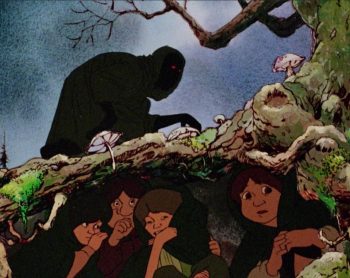 Ralphi Bakshi’s rotoscoped Ring Wraith and the hobbits
Ralphi Bakshi’s rotoscoped Ring Wraith and the hobbits
This time around, the outward journey of the hobbits, Frodo, Sam, Merry, and Pippin, from the bucolic seclusion of the Shire, by degrees, into the wider, wilder world they have been largely unaware of caught my eye. The first encounter occurs while still in the Shire when they hear the sound of hooves coming along the road.
The hoofs drew nearer. They had no time to find any hiding-place better than the general darkness under the trees; Sam and Pippin crouched behind a large tree-bole, while Frodo crept back a few yards towards the lane. It showed grey and pale, a line of fading light through the wood. Above it the stars were thick in the dim sky, but there was no moon.
The sound of hoofs stopped. As Frodo watched he saw something dark pass across the lighter space between two trees, and then halt. It looked like the black shade of a horse led by a smaller black shadow. The black shadow stood close to the point where they had left the path, and it swayed from side to side. Frodo thought he heard the sound of snuffling. The shadow bent to the ground, and then began to crawl towards him.
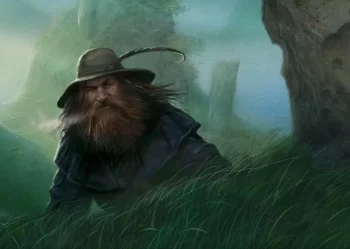 Tom Bombadil by John Howe
Tom Bombadil by John Howe
The second and stranger encounter occurs in the shadowed depths of the Old Forest. Once, many years ago, something from the Forest had somehow pushed back against the invading hobbits. In retaliation, the hobbits burned many of the trees and built a great hedge to keep the rest of them at bay. Once inside the dark woods, the hobbits are lured and trapped by an ancient, malicious willow tree only to be saved by one of the most divisive figures in fantasy – Tom Bombabil. Tom saves the hobbits again, as they continue away from their homes, and are trapped by evil spirits infesting ancient barrows. Their experience in the barrows gives visions to the hobbits, impressing on them the depths and width of the world outside their cozy borders.
This brings me to the second thing I paid more attention to on this reading: the moments of mystery and strangeness. Some hate Bombadil because he’s too frivolous. Others maintain he was just jammed into the story because Tolkien, who’d created the character for an earlier poem, liked him too much. I hold to the theory that for the whole first part of The Fellowship, Tolkien was feeling his way into the story, letting events grow spontaneously and I love the character, silly songs and all.
In the seemingly areligious Middle-earth (that’s a complicated bit of business for some other time, perhaps), Bombabil feels distinctly divine. He is married to the daughter of the river, “knew the dark under the stars when it was fearless – before the Dark Lord came from Outside,” and sings down the very stones of the haunted barrow. When asked about him, Tolkien responded that he was “not an important person – to the narrative” and that “he represents something that I feel important, though I would not be prepared to analyse the feeling precisely. I would not, however, have left him in, if he did not have some kind of function.” He alone, of everyone in Middle-earth, is impervious to the power of the Ring. It doesn’t work for him and he has no desire to own it. I love that there is no explanation for him, an element that doesn’t find an explanation in any of the vast history Tolkien composed for Middle-earth. To quote his wife, when asked who he is, she simply replies, “He is.”
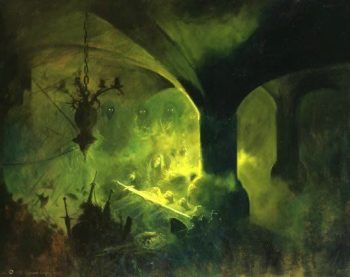 Barrow Wight by Paul Raymond Gregory
Barrow Wight by Paul Raymond Gregory
Being swallowed alive by a willow tree, evil or otherwise, is of course fairy tale strange. The haunted barrows and the capture of the hobbits by the barrow wights are more akin to the Germanic tales that partially inspired Tolkien. Trying to cross the downs, the hobbits find themselves imprisoned within one of the barrows. It is the eeriest point in the entire book, and could easily have been lifted from some skald’s ancient tale sung by the fireside.
As he lay there, thinking and getting a hold of himself, he noticed all at once that the darkness was slowly giving way: a pale greenish light was growing round him. It did not at first show him what kind of a place he was in, for the light seemed to be coming out of himself, and from the floor beside him, and had not yet reached the roof or wall. He turned, and there in the cold glow he saw lying beside him Sam, Pippin, and Merry. They were on their backs, and their faces looked deathly pale; and they were clad in white. About them lay many treasures, of gold maybe, though in that light they looked cold and unlovely. On their heads were circlets, gold chains were about their waists, and on their fingers were many rings. Swords lay by their sides, and shields were at their feet. But across their three necks lay one long naked sword.
Suddenly a song began: a cold murmur, rising and falling. The voice seemed far away and immeasurably dreary, sometimes high in the air and thin, sometimes like a low moan from the ground. Out of the formless stream of sad but horrible sounds, strings of words would now and again shape themselves: grim, hard, cold words, heartless and miserable. The night was railing against the morning of which it was bereaved, and the cold was cursing the warmth for which it hungered. Frodo was chilled to the marrow. After a while the song became clearer, and with dread in his heart he perceived that it had changed into an incantation:
Cold be hand and heart and bone,
and cold be sleep under stone:
never more to wake on stony bed,
never, till the Sun fails and the Moon is dead.
In the black wind the stars shall die,
and still on gold here let them lie,
till the dark lord lifts his hand
over dead sea and withered land.
He heard behind his head a creaking and scraping sound. Raising himself on one arm he looked, and saw now in the pale light that they were in a kind of passage which behind them turned a corner. Round the corner a long arm was groping, walking on its fingers towards Sam, who was lying nearest, and towards the hilt of the sword that lay upon him.
None of these moments make it into Peter Jackson’s film of The Fellowship of the Ring. They don’t serve the narrative thrust Jackson chose to focus on. What they do is help convey the transition of the hobbits — and the story — from the pocket world of the Shire to the real world, one beset by betrayal, ravaging armies, and supernatural evil. Taken together with the dangerous episodes, they serve as a sort of veil the hobbits, representatives of the traditional, insular England Tolkien loved, must pass through before the real quest — the one to destroy the Ring — can begin.
Which leads me to Jackson’s movie, The Fellowship of the Ring (2001). That’s in fact what started this whole undertaking. Even though I’m on record disliking the movies, I needed something on in the background while doing some work and something with swords and magic seemed the right choice. Within minutes I found my dislike bubbling up. Soon it was boiling over. The easiest solution was to just pick up the books and read them again — which I did.
The thing is, I kept watching the movie, quickly followed by the other two. It’s the closest I’ve come to really hate watching anything in my life. I’ll go into more detail when I get to The Two Towers and The Return of the King as they deviate the most from the books.
I don’t dislike the movies for things Jackson didn’t do. If Verdi can edit Shakespeare, Jackson can edit Tolkien. I understand leaving out all the things I described. While I think their elimination changes the nature of the story, removing them to speed up the film’s momentum makes cinematic sense. The movie is intended as an exciting, action-filled movie, not a travelogue. Characters are compressed or excised in service of fitting a large book onto the screen. It happens all the time, often quite successfully. And still, I dislike the movies.
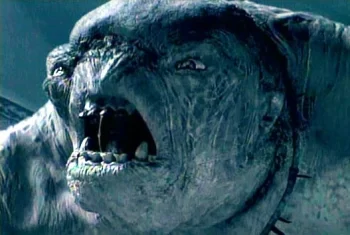 My easiest complaint is with filmmaking choices. First, are the moments of slow motion. Frodo getting stabbed and an uruk-hai running along a riverbank are the two moments that jump to mind most readily. They look cheap and terrible and stand out in a movie that lavished millions on looking good. Much worse is the fight and flight through Moria which becomes increasingly computer game-like as it proceeds. There is no architectural explanation that can possibly justify the staircase that collapses as our heroes are running down it. The battle in the book is much better choreographed and makes much more sense. Jackson’s camera work is skittery and nothing ever stays in a shot long enough to make much of an impression. The interaction between the characters and CGI troll looked fake twenty-plus years ago and only more so now. There are numerous other moments of interpretation I could argue about. Jackson always chose BIGGER and BOLDER, eschewing texture, subtlety, and atmosphere.
My easiest complaint is with filmmaking choices. First, are the moments of slow motion. Frodo getting stabbed and an uruk-hai running along a riverbank are the two moments that jump to mind most readily. They look cheap and terrible and stand out in a movie that lavished millions on looking good. Much worse is the fight and flight through Moria which becomes increasingly computer game-like as it proceeds. There is no architectural explanation that can possibly justify the staircase that collapses as our heroes are running down it. The battle in the book is much better choreographed and makes much more sense. Jackson’s camera work is skittery and nothing ever stays in a shot long enough to make much of an impression. The interaction between the characters and CGI troll looked fake twenty-plus years ago and only more so now. There are numerous other moments of interpretation I could argue about. Jackson always chose BIGGER and BOLDER, eschewing texture, subtlety, and atmosphere.
Tolkien’s Lord of the Rings isn’t devoid of humor. There’s Bilbo’s speech at his party and the discovery of the petrified trolls from The Hobbit. The thing is, there isn’t any slapstick. Not a bit. By which I mean especially pan-swinging, or dwarf-tossing. It’s awful and, like the slow motion, stands out in a movie that presents itself as a serious interpretation of a serious literary work.
My greater criticism is the film’s handling of the characters. Merry and Pippin are reduced to bad comic relief, instead of the clever conspirators who prove brave enough to maim and kill several orcs before Boromir is killed. Gandalf acts like a terrified fool in one moment and isn’t clever enough to solve the riddle to open the Gates of Moria himself. Boromir is more despicable seeming on the screen, instead of a man slowly being driven to madness by the Ring.
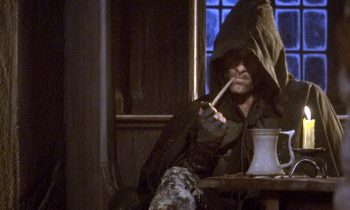 Most egregiously, Aragorn, born of an ancient line of kings, and raised to be a king, becomes a reluctant hero on the screen. We’re told he turned from the path of kingship long ago and later he says being king isn’t his goal. Aragorn is a man who has been a hero several times during his long life prior to the book, all for the purpose of opposing Sauron and restoring the kingship of a reunited kingdom. Finally, Elrond’s sworn he may only marry his daughter, Arwen, if he succeeds in his quest to become king.
Most egregiously, Aragorn, born of an ancient line of kings, and raised to be a king, becomes a reluctant hero on the screen. We’re told he turned from the path of kingship long ago and later he says being king isn’t his goal. Aragorn is a man who has been a hero several times during his long life prior to the book, all for the purpose of opposing Sauron and restoring the kingship of a reunited kingdom. Finally, Elrond’s sworn he may only marry his daughter, Arwen, if he succeeds in his quest to become king.
Instead of channeling the great heroes and chieftains of legend, Aragorn is reduced to, using one online site’s description, emo Aragorn. It feels like Jackson was incapable of believing someone could simply be portrayed as a hero, but needed to go on some sort of journey that almost forced him into choosing to be king.
There are loads of other things I don’t like about the movie. Most, though, are matters of taste, I suppose. Neither Viggo Mortensen nor Sean Bean are physically big enough or powerful enough for their roles. I don’t like many of the costumes, and I hate the portrayal of the hobbits as country bumpkins and Frodo is too young. The worst thing in the extended edition is the elf guard at Lothlorien’s five o’clock shadow.
I do like some things. Ian McKellen looks perfect. The Shire and the much of the wilderness countryside look like how I imagine they should. Galadriel taking on a terrifying visage when she imagines what she’d be with the One Ring is as exactly disturbing as it should be. Best of all, the death of Boromir, something that doesn’t come across as grandly tragic in the book as it should, is done brilliantly on the screen. That’s about it, though.
If this all seems a bit rambling, I’m sorry. Like last month, the spirit of Tolkien overpowered any original intentions I had. The result is this wandering around how The Fellowship of the Ring struck me on this tenth, or whatever it is, reading. I think I concentrated on those early chapters because excised from the movies, they are unknown to many who’ve never actually read the books. The book is much looser and messier than the movies and maybe that’s a reason I prefer it.
Fletcher Vredenburgh writes a column each first Sunday of the month at Black Gate, mostly about older books he hasn’t read before. He also posts at his own site, Stuff I Like when his muse hits him.
Roy Thomas and the Legacy of Conan the Barbarian
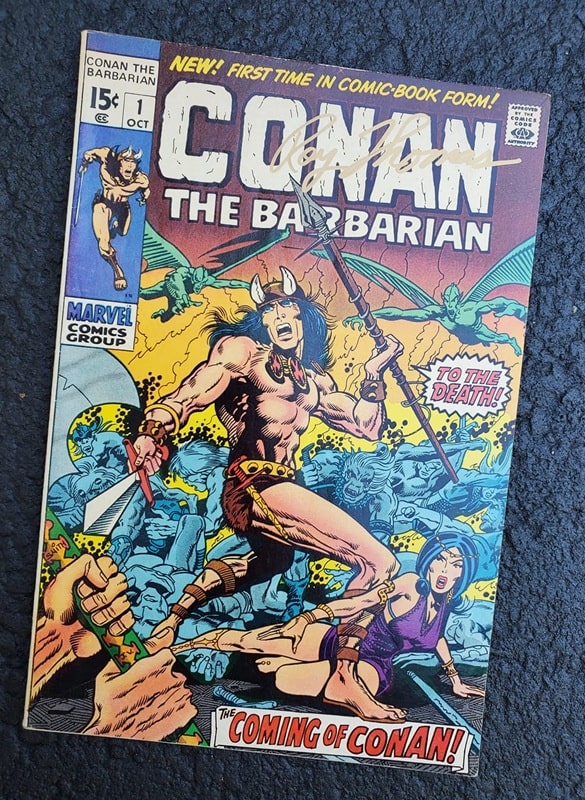 Conan The Barbarian #1 (Marvel Comics, October 1970). Art by Barry Windsor Smith
Conan The Barbarian #1 (Marvel Comics, October 1970). Art by Barry Windsor Smith
The package I received on July 6, 2020 brought me great joy! Roy Thomas is my favorite comic book writer. I correspond with him occasionally, and he is quite generous with his time, sharing his thoughts and memories. Very similar to how Gary Gygax did this, treating every fan with dignity and respect. A true gentleman.
I thanked Roy in my latest Hyperborea adventure book, The Sea-Wolf’s Daughter, because it included a character inspired by one of his creations. I sent him a copy of the book, and along with it my personal copy of Conan the Barbarian #1, to be signed by the author. Well, here it is! (He has an agency that normally handles this sort of thing, but he made an exception for me.) Excelsior!
 Cover art for Conan the Barbarian #58, by John Romita Sr., story by Roy Thomas (Marvel Comics, January 1976)
Cover art for Conan the Barbarian #58, by John Romita Sr., story by Roy Thomas (Marvel Comics, January 1976)
It is my humble opinion that of all the Conan pastiche writers, Roy Thomas is among the finest. But because he wrote in the comics industry, he’s often not afforded the same prestige as other Conan pastiche writers, such as L. Sprague de Camp, Lin Carter, Karl Edward Wagner, Robert Jordan, et al.
Thomas’ run starring Conan and Belit (the Queen of the Black Coast) started with this issue (#58) and concluded with the iconic issue #100. It is a treasure to read.
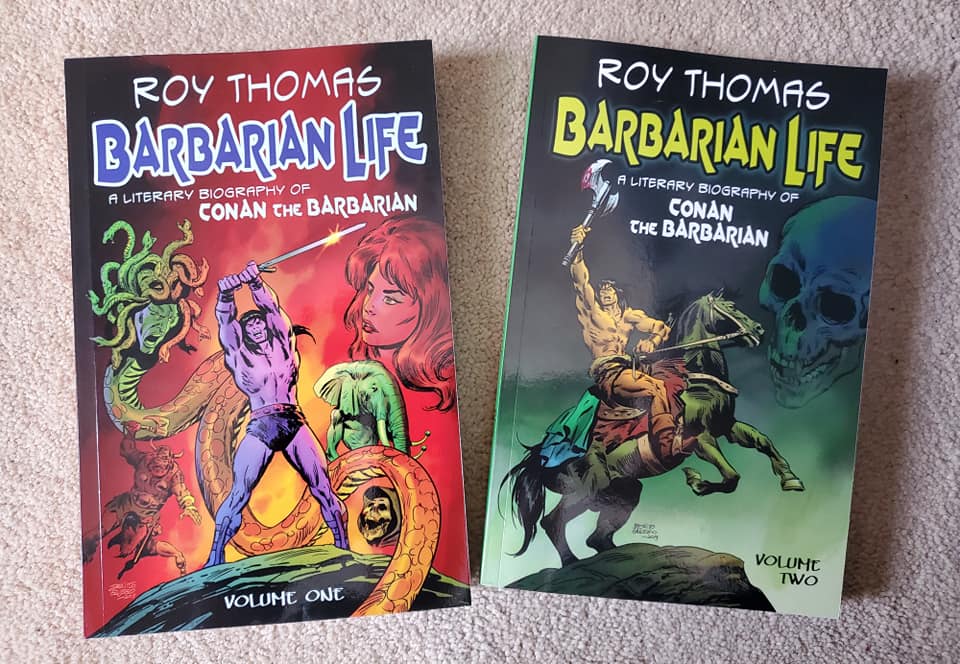 The first two volumes of Barbarian Life by Roy Thomas (Pulp Hero Press, December 7, 2018 and November 29, 2019)
The first two volumes of Barbarian Life by Roy Thomas (Pulp Hero Press, December 7, 2018 and November 29, 2019)
In the three volumes of Barbarian Life, Roy Thomas reflects on each of the first 100 issues of Conan the Barbarian, by Marvel Comics — which he wrote every issue of, from 1970 to 1979.
Roy is responsible for taking part in the creation of many Marvel and DC characters that have been featured in blockbuster films, but he will be the first to tell you that his favorite job was writing Conan the Barbarian, adapting and expanding on the works of Robert E. Howard and several other pastiche writers. What an incredible idea by Mr. Bob Mclain of Pulp Hero Press!
 Back covers for Barbarian Life, volumes 1 and 2
Back covers for Barbarian Life, volumes 1 and 2
I can’t wait to dig into these two volumes; in fact, I have this crazy notion in me noggin about starting a blog in which I go through all 100 issues, reading the comic, followed by its respective chapter entry in the literary biography.
I’ve never blogged before, but I think this could be my motivation to give it a try in 2020. Would anyone be interested reading something like this?
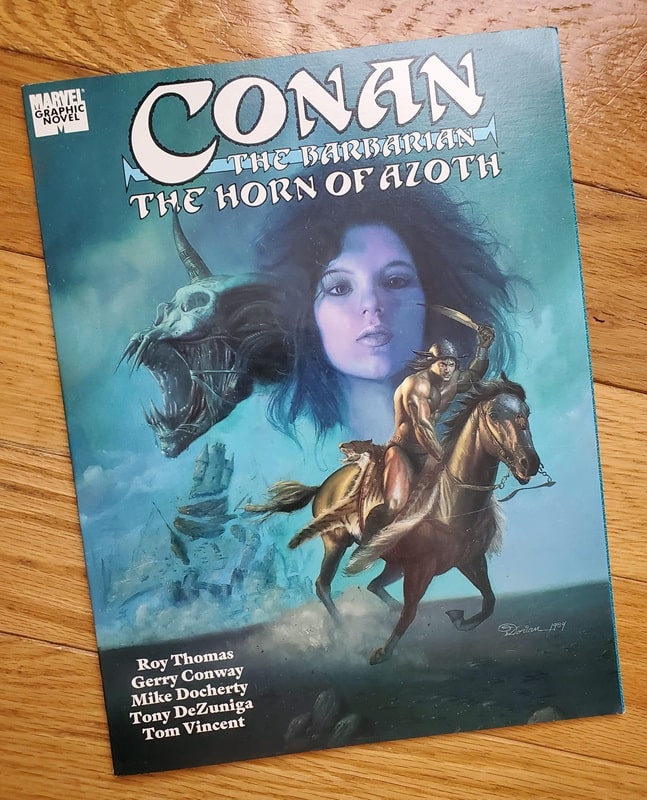 Conan: The Horn of Azoth, by Roy Thomas, Gerry Conway, Mike Docherty, Tony DeZungia, and Tom Vincent (Marvel Enterprises, January 1, 1990)
Conan: The Horn of Azoth, by Roy Thomas, Gerry Conway, Mike Docherty, Tony DeZungia, and Tom Vincent (Marvel Enterprises, January 1, 1990)
Above is Conan: The Horn of Azoth, aka Conan, King of Thieves, aka Conan the Destroyer.
Written by Roy Thomas and Gerry Conway, penciled by Mike Docherty, inked by Tony DeZuniga, and colored by Tom Vincent, this graphic novel, published in 1990 by Marvel Comics, has a fascinating publication history. For the complete history, definitely read the introduction by Thomas and Conway. What I am presenting is an abridged version of that story.
– It didn’t start off as a graphic novel; rather, it was the screenplay for the second Conan film, starring Arnold Schwarzenegger.
– In 1982, Universal producer Ed Pressman hired Thomas and Conway to write the script. Roy Thomas had previously worked as a consultant for the Conan the Barbarian.
– Roger Donaldson was to be the director.
– Barry Windsor-Smith was brought in to do concept art.
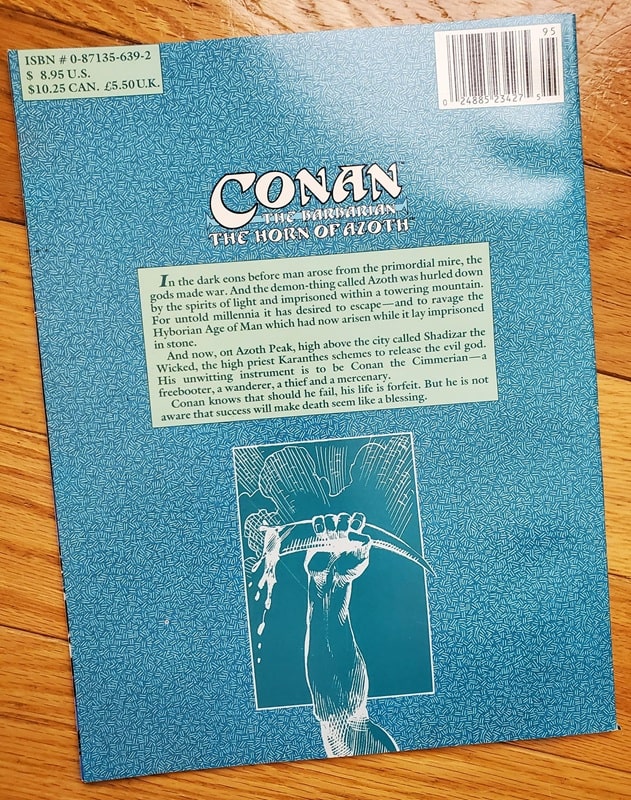 Back cover for Conan: The Horn of Azoth
Back cover for Conan: The Horn of Azoth
– Universal producer Pressman wanted it to be “lighter” (PG), so Thomas and Conway had to jettison some of their ideas. Result was their screenplay, Conan, King of Thieves.
– Pressman loved the screenplay, but sold his rights to Dino DeLaurentis.
– Dino was less familiar with REH and Conan, and he had his own ideas.
– The director, Donaldson, was removed. Dino wanted a lot of changes to the script. The storyline was continually adjusted.
– Dino hated leeches and rats and had them removed from the script. He wanted no stop-animation monster transformation, so the main monster had to be changed.
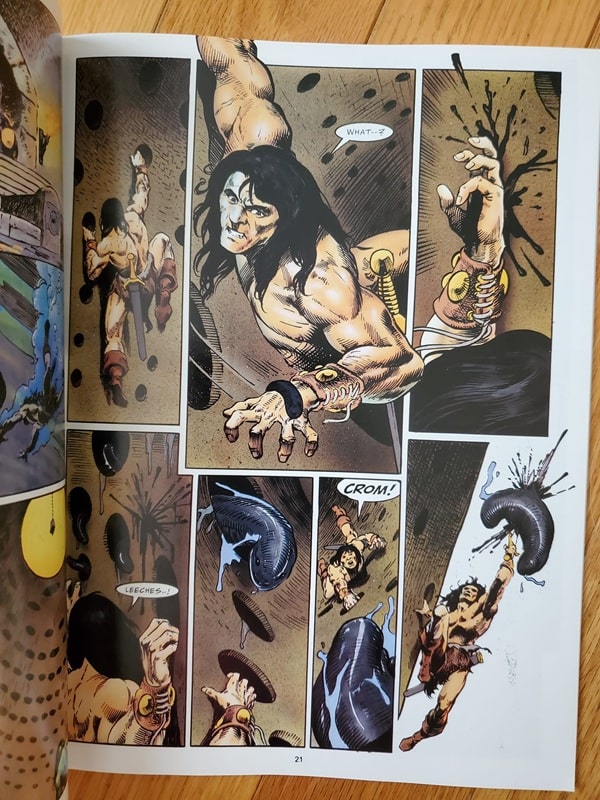
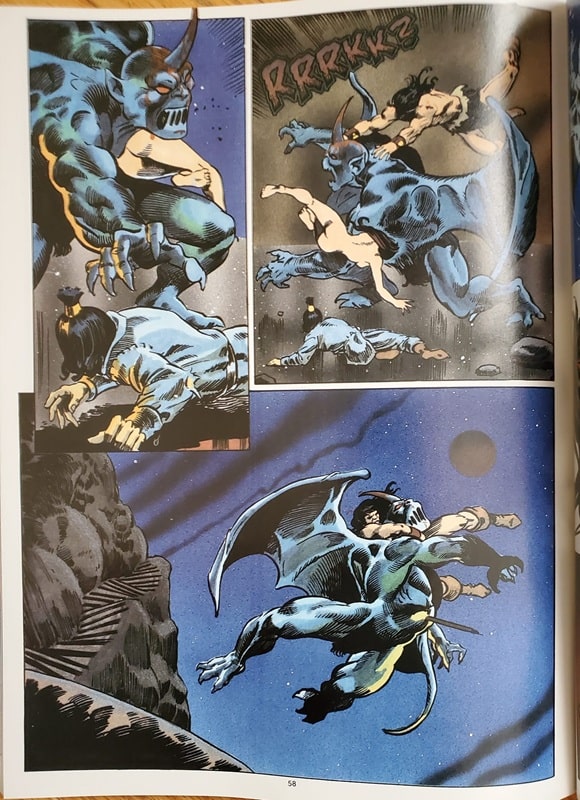
Interiors from The Horn of Azoth
– Richard Fleischer was hired as director. He came in with his own ideas and hired a new screenwriter to replace Thomas and Conway.
– Thomas and Conway had to fight for a screen credit in Conan the Destroyer. The Writers Guild decided that there were significant elements of the Thomas and Conway script that were retained, so they won.
– The original screenplay by Thomas and Conway was well-liked in the industry and led to further work for the two.
– Marvel editor Craig Anderson loved it, too, so they turned it from a 130-page screenplay to a 62-page graphic novel, published by Marvel.
And there you have it, Conan: The Horn of Azoth.
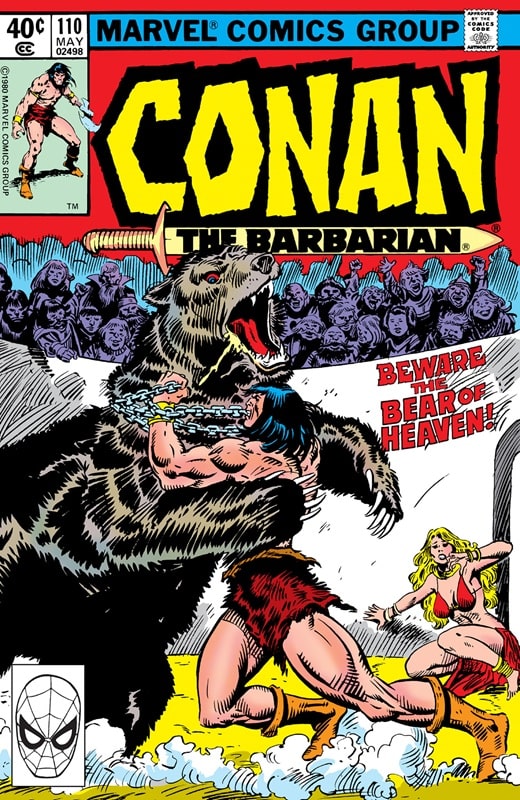 Conan the Barbarian #110, by Roy Thomas, John Buscema, and Al Milgrom (Marvel Comics, May 1980)
Conan the Barbarian #110, by Roy Thomas, John Buscema, and Al Milgrom (Marvel Comics, May 1980)
This is the first Conan the Barbarian comic that I ever read. Released in February of 1980 (with a cover date of May 1980), I would have been eight years old, soon to be nine.
I remember reading it over and over at my grandmother’s house, then redrawing it, too, making my own versions of Conan choking out a massive bear using a chain.
 Conan by Jack Kirby
Conan by Jack Kirby
And here’s Conan the Barbarian, by Jack Kirby. Jack was not known for many Conan illustrations, but by Crom, this one is incredible.
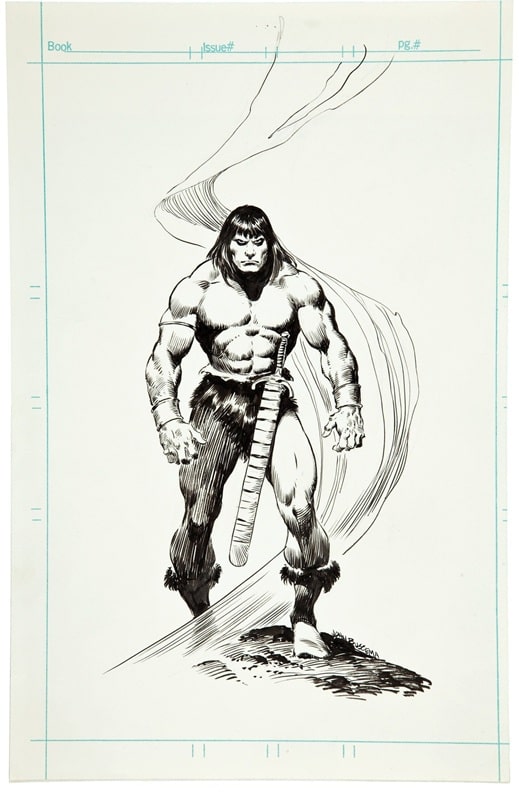 Conan by John Buscema
Conan by John Buscema
January 10, 2025 marked 23 years since the passing of the great John Buscema. His resume of artistic works is astonishing, to say the least, but for many of us (myself included), we will always remember him most for his Conan works (Conan the Barbarian, Savage Sword of Conan). When I read a Conan story (by REH or a pastiche author), and I picture Conan in my mind’s eye, I am seeing Big John’s rendition of the Cimmerian barbarian. Hail to John!
Jeffrey P. Talanian’s last article for Black Gate was The Intersection of Hobbies: Dungeons & Dragons, John Eric Holmes, and Tarzan. He is the creator and publisher of the Hyperborea sword-and-sorcery and weird science-fantasy RPG from North Wind Adventures. He was the co-author, with E. Gary Gygax, of the Castle Zagyg releases, including several Yggsburgh city supplements, Castle Zagyg: The East Mark Gazetteer, and Castle Zagyg: The Upper Works. Read Gabe Gybing’s interview with Jeffrey here, and follow his latest projects on Facebook and at www.hyperborea.tv.
Midnight Rambles: H.P. Lovecraft in Gotham by David J. Goodwin
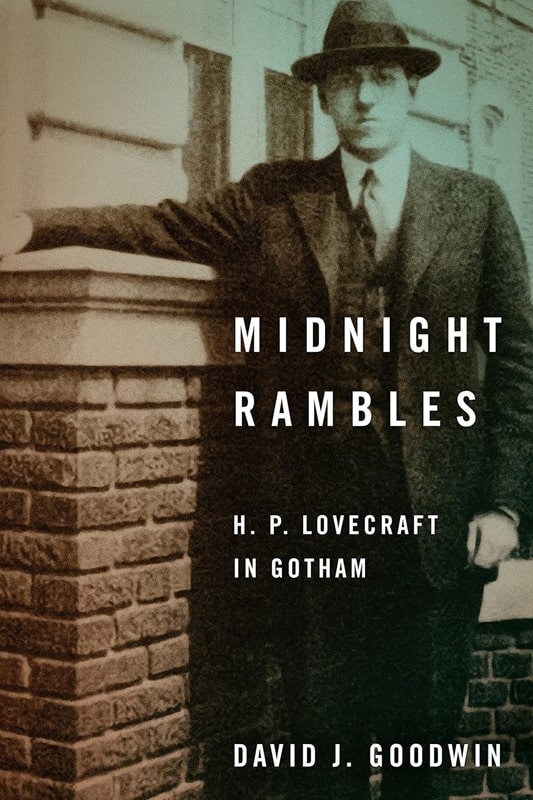
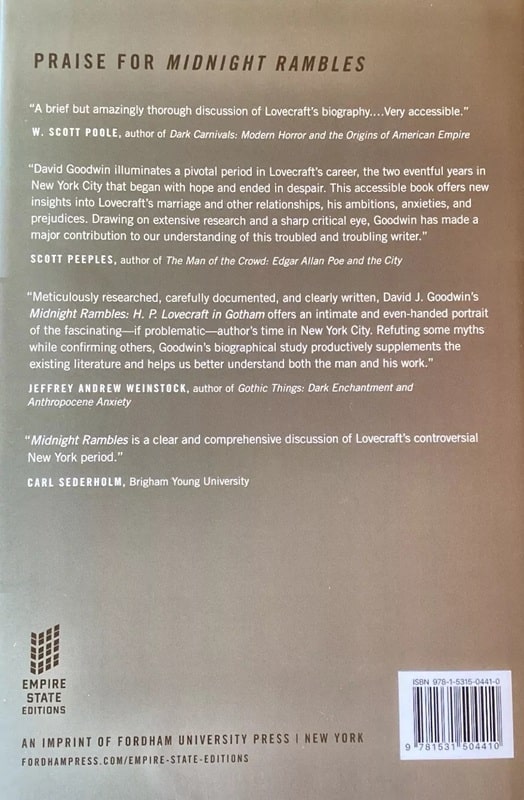
Midnight Rambles: H.P. Lovecraft in Gotham (Empire State Editions, November 7, 2023)
David J. Goodwin’s Midnight Rambles: H.P. Lovecraft in Gotham provides a narrow and deep slice of H. P. Lovecraft’s biography, detailing his personal and professional life during the few years he lived in New York City. Deeply researched and full of connections, Goodwin provides correction to some long-held Lovecraft biographical details and does not flinch from detailing Lovecraft’s innate hostility to non-WASP groups, ably describing it in the context of a deeply racist and anti-semitic society.
There are very few people who can claim to be expert on the life and work of H.P. Lovecraft, and Goodwin’s book puts him in range of that small number (such as S.T. Joshi). As he’s written and presented about Lovecraft more than half a dozen times, Goodwin seems poised to rise to stand among the critics named when the storied and controversial author rises in conversation, if he’s not there already. Learn more about Goodwin here.
Goodwin faces a difficult biographical subject in writer H.P. Lovecraft. Much material of signal importance during this time is unavailable. His spouse, Sonia Greene, destroyed some 400 of Lovecraft’s letters, largely from the period of interest for this text. Lovecraft’s aunts, demonstrably hostile to his marriage to Greene, discarded dozens of postcards when Lovecraft moved to New York through the simple expedient of giving away everything he had not specifically requested be sent to his new lodgings in the city. These details sample the rich trove of information about Lovecraft in Goodwin’s text.
Despite these holes in the biographical record, Goodwin’s ample research buttresses his assertions about the writer’s experiences in Gotham. The period constitutes a fertile time for Lovecraft, a locus that saw the invention of what would later be called the Cthulhu mythos. That it also saw the creation of the author’s least palatable, racist fiction represents an unavoidable truth. For each of the Lovecraft stories written during his residence in the city, Goodwin provides detailed research that helps illuminate the influences likely to have pressed upon the author. However, the biographer also includes historical demographic information to fully contextualize the lack of basis for any of Lovecraft’s many claims, a thread illustrating Lovecraft’s self-mythologizing nature.
The architecture of houses, the urban design of towns and cities was always of interest to Lovecraft, who, Goodwin explains, ambled extraordinary distances to view places and structures of interest. Readers familiar with John Crowley’s Little, Big may notice a reference to a real life builder important to New York that appears in that fictional text.
Lovecraft’s relationship with Sonia Greene merits several chapters and encapsulates their meeting, courtship, sudden marriage, and ultimate divorce that neatly marks the end of Lovecraft’s time in the city. Goodwin works wonders with the limited material available on this window to the past and readers familiar with Lovecraft biographies of broader scope will find material of interest in these pages. It is here Goodwin provides the price of admission for this text. Owing to an absence of a signed decree of divorce, past biographers have stated the author failed to sign those papers, meaning Greene’s subsequent marriage in California was bigamous.
Goodwin effectively implodes this “never signed” myth with solid evidence to the contrary, noting in addition that the loss of legal documentation was not uncommon in the 1920s. This conclusion is an exception among many assertions buttressed with the language of guesswork. Of all the guesses in Midnight Rambles, none struck this reviewer as unlikely or a reach. The biographer confines himself to likely scenarios, allowing for the many connections to form a compelling web to wrap these Lovecraft years for readers.
Readers interested in Lovecraft will find Midnight Rambles required reading. In this readable and at the same time admirably academic work (the two do not always meet amicably) even casual readers of Lovecraft may find information of interest. While Lovecraft expressed vehement racist and anti-semitic views, he married a Jew. While holding typical for the era dislike for homosexuals, one of his New York City walking buddies and long time correspondent was gay. Understanding this author, who some say serves as the pennant-waver for American horror fiction in sequence after Edgar Allan Poe, is made easier by Goodwin’s work. I recommend it to Lovecraft enthusiasts and any who find interest in the literary history of Gotham, our style and fashion capital.
Edward Carmien’s last article for Black Gate was When Your First Language is Role-Playing Games. His short stories “Before the Wind” and “Knives Under the Spring Moon” appeared in the print version on Black Gate in 2007 and 2008. He maintains a daily blog on writing at edwardcarmien.wordpress.com
Goth Chick News: Throwback Thursday – When Mickey Rourke Met Lucifer
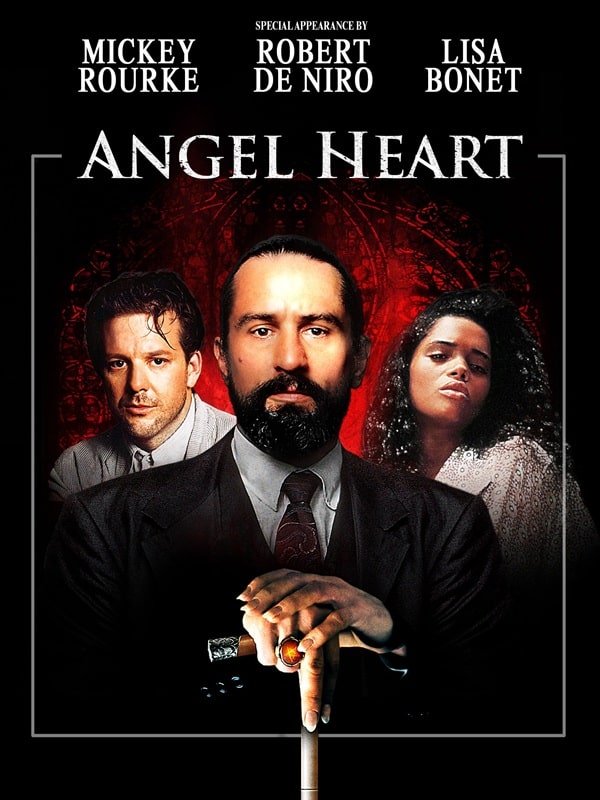 Angel Heart (Tri-Star Pictures, March 6, 1987)
Angel Heart (Tri-Star Pictures, March 6, 1987)
This is how my brain works sometimes.
This week Deadline reported that Robert De Niro will be starring in an upcoming crime drama for Netflix called The Whisper Man based on a novel by the same name. That made me think that when I last saw De Niro, the dude looked pretty old, and that starring in a multi-installment series for Netflix would be pretty taxing. That led me to IMDB to find out how old he really is (De Niro is 81), which resulted in going down the rabbit hole of his incredible career, which led me to Angel Heart (1987).
I had all but forgotten about this film, but the minute I read the name all this controversial stuff about it started resurfacing in my mind. Honestly, I couldn’t recall if Angel Heart was really all that controversial, or if I remembered it wrong and naturally this resulted in a lost afternoon reading everything about it I could get my hands on.
So, here we are and yes, the movie was steeped in controversy.
 Mickey Rourke and Lisa Bonet in Angel Heart
Mickey Rourke and Lisa Bonet in Angel Heart
Directed by Alan Parker (Midnight Express) and starring the pre-cosmetic surgery hotness that was a young Mickey Rourke, Robert De Niro, and Lisa Bonet (one of those adorable Cosby Show kids), Angel Heart blended the genres of psychological thriller, neo-noir, and horror. Set in 1955 New Orleans, it tells the story of small-time private investigator Harry Angel (Rourke) who is hired by a man who calls himself Louis Cypher (De Niro) to track down a singer named Johnny Favorite.
The investigation takes Angel into the backwaters of the Louisiana bayou where he meets the luscious young Epiphany Proudfoot (Bonet), who also happens to be a voodoo priestess. Suddenly, the trail Angel is following becomes soaked in blood and gruesome murder. So, who is trying to keep Angel from finding his quarry?
To kick off the reasons Angel Heart became a cult classic, after it pretty much bombed at the box office, was that at the time Bonet was best known for her role as Denise Huxtable on The Cosby Show, a wholesome family sitcom. Bonet’s Angel Heart performance included a graphic sex scene and nudity, which led to backlash for her career and to her public image.
Though it didn’t exactly ruin her in Hollywood, Angel Heart made it challenging for Bonet to find roles that matched her previous success. Producers and casting agents often pigeonhole actresses based on public perception, and Bonet’s decision to take on such a provocative role led to her being seen as “too edgy” for mainstream projects (for another example, seee Elizabeth Berkley [Saved by the Bell] and her movie Showgirl [1995]).
While we’re on the topic of sex scenes, the most infamous Angel Heart controversy involved the raw sex scene between Rourke and Bonet. This scene, which featured nudity, blood, and disturbing imagery, pushed boundaries for its time, not the least of which was because of the revelation of an incestuous relationship between Rourke’s and Bonet’s characters. This plot twist, coupled with the explicitness of the scene, sparked outrage and made the film even more polarizing.
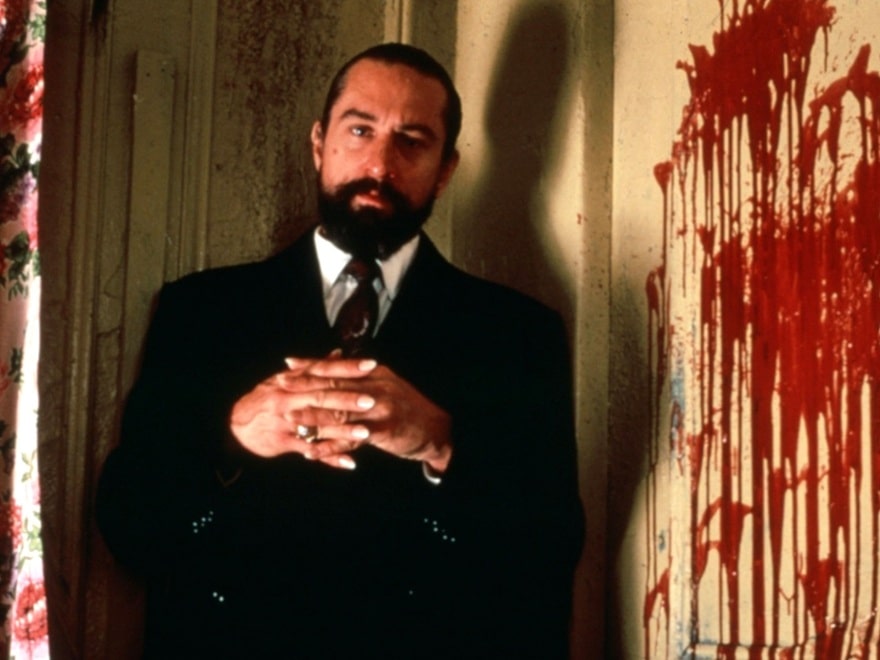 Robert De Niro as Louis Cyphre
Robert De Niro as Louis Cyphre
The film’s depiction of voodoo practices, combined with De Niro’s portrayal of Louis Cyphre (an alias for Lucifer if that hasn’t jumped out at you yet), upset religious groups to no end. De Niro’s performance, though praised by audiences for its eerie subtlety, drew vocal criticism for allegedly glamorizing the devil. Critics accused Angel Heart of promoting occultism and blasphemy, while others argued that the film perpetuated stereotypes about voodoo and Haitian culture, painting them as sinister or evil.
Then there was the violence. Angel Heart is graphically violent, with several brutal and unsettling death scenes, including one involving a character’s heart being ripped out and another being boiled alive in a large vat of jambalaya. The overall dark tones and the depiction of psychological torment left many viewers disturbed, especially as Harry Angel’s true identity and fate are revealed.
The Motion Picture Association of America (MPAA) initially gave the film an X rating. Alan Parker had to cut approximately 10 seconds of footage from Bonet and Rourke’s nude romp to secure an R rating, though many still found the final version shocking. Ironically all the goriest scenes remained intact. You’d never imagine De Niro eating a hard-boiled egg could be so unnerving.
 Mickey Rourke then and now
Mickey Rourke then and now
Yes, I immediately had to give Angel Heart a rewatch – it’s pretty much streaming everywhere. Frankly, I’ve always liked it in the same way I’ve always liked The Ninth Gate (1999) with Johnny Depp. Just suspend your disbelief and go there, provided you can get around the distraction of how the actors have changed (not just aged) in the years since.
A Masterful Three Novella Original Anthology: The New Atlantis, edited by Robert Silverberg
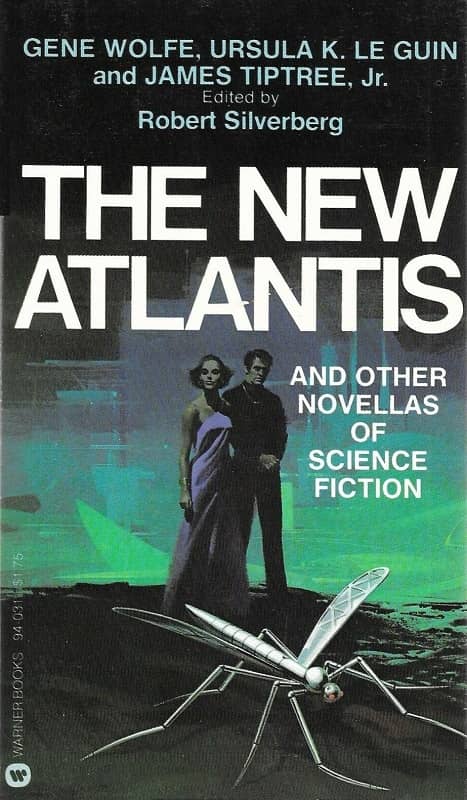
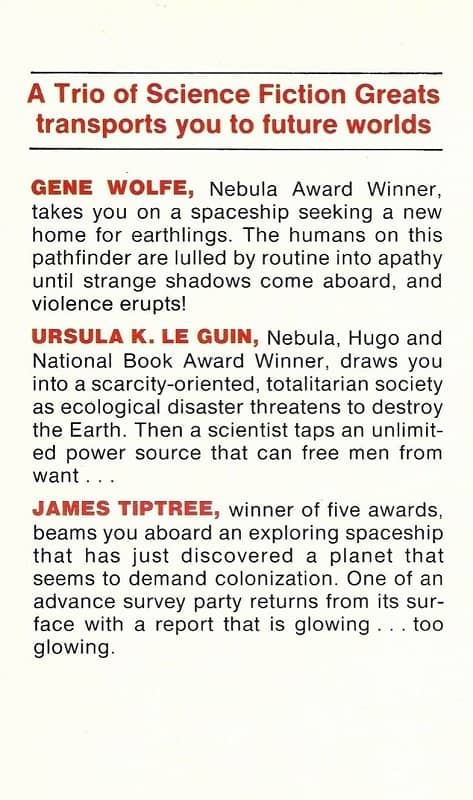
The New Atlantis (Warner Books paperback reprint, 1978). Cover by Lou Feck
My latest look at a book from the 1970s treats a major anthology from 1975. The New Atlantis and Other Novellas collects three long stories: “Silhouette,” by Gene Wolfe; “The New Atlantis,” by Ursula K. Le Guin, and “A Momentary Taste of Being,” by James Tiptree, Jr. The project received plenty of notice at awards time – the book as a whole was fifth in the Locus Poll for Best Anthology, “A Momentary Taste of Being” and “Silhouette” were 7th and 9th, respectively, in the Locus Poll for Best Novella, while “The New Atlantis” won the Locus Poll for Best Novelette, and received a Hugo nomination in that category, and both it and the Tiptree also got Nebula nominations.
Let’s look at the individual stories first.
“Silhouette” by Gene WolfeGene Wolfe was a remarkable writer at all lengths — he produced brilliant short-shorts, short stories, novelettes, novellas, novels, series of novels, even a series of series of novels. “Silhouette,” at about 20,000 words, is one of his novellas — and it may be that the novella was his ideal length.
[Click the images for masterful versions.]
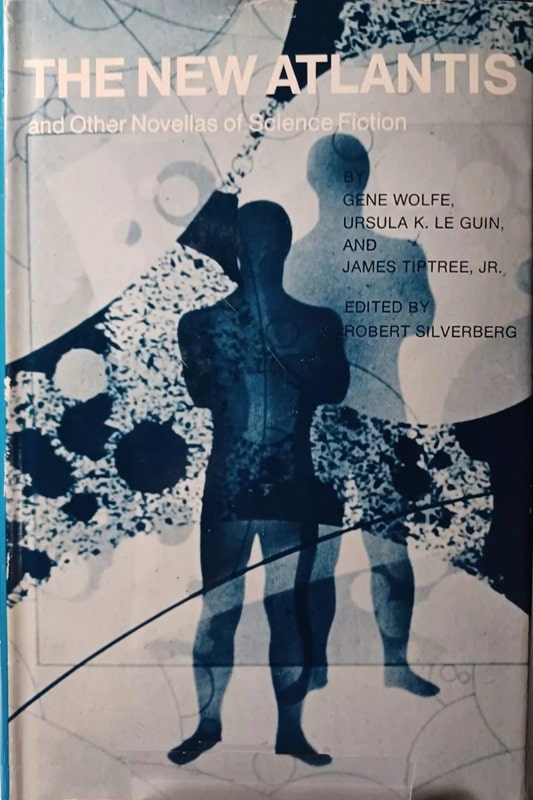 The New Atlantis hardcover edition (Hawthorn Books/Science Fiction Book Club, 1990). Cover by Jorge Hernandez
The New Atlantis hardcover edition (Hawthorn Books/Science Fiction Book Club, 1990). Cover by Jorge Hernandez
At any rate he wrote some 15 novellas, ranging from “The Fifth Head of Cerberus” in 1972, to “Memorare” in 2007; and of these at least “The Fifth Head of Cerberus,” “The Death of Dr. Island,” “Tracking Song,” “The Eyeflash Miracles,” “Seven American Nights,” and “The Ziggurat” rank among the great novellas in SF history. I don’t rank “Silhouette” quite with those stories, but it is a powerful and original piece.
A starship has reached a planet called Neuerrdraht, and the crew are considering whether it is suitable for human habitation. The viewpoint character is Johann, one of the officers, who is skeptical about the prospect of colonization. The ship is deteriorating, however, and the Captain is insistent. There are other factions, including a group that worships the ship’s computer… We get a flavor of life on the ship — a certain grunginess, oppressiveness, with features such as women (except for the Captain) being required to sleep with officers whenever available. Johann has dreams of walking on the surface of the planet, and he is visited by a — shadow? his shadow? something from the planet? A silhouette, at any rate!
The story continues in a disturbing fashion, as the atmosphere on the ship becomes darker. There’s a sense that the ship’s decay mirrors the decay on Earth, from which they had escaped. Johann finds himself confronting the computer-worshippers, and a group that seems intent on mutiny, and people ready to hurt him if he won’t cooperate. With the ambiguous help of the shadow being, he gets through all this, and then comes the actual mutiny, with chaotic and unexpected results.
This is a very good story, but as I said not quite Wolfe at his best. It lacks the truly mysterious aspect that I love most in Wolfe’s work. As I suggest above, I think the best way to read it is to see conditions on the ship as a sort of metaphor — a reflection, even a silhouette — of conditions on the Earth they left. The ship is full of class divisions, and sexual divisions: it’s a particularly oppressive place for women, it seems. And there is no reason to expect colonizing Neuerrdraht will solve anything.
“The New Atlantis” by Ursula K. Le GuinThis is the shortest of these stories, at perhaps 10,000 words. It is set in a ruined near future (to 1975) US, in which climate change has caused sea levels to rise and some parts of the coast are submerged. The country is ruled by a sort of corporatist tyranny, which to my eyes had both right-wing and left-wing elements. The narrator lives in Portland, and her husband has just returned from a prison camp — but they have to be careful, as in this future marriage is illegal. She is a musician, and her husband is a mathematician. And there are rumors of new continents emerging from the ocean.
The narrative alternates passages in the narrator’s POV, with passages from the POV of a mysterious underwater being. The narrator tells of ordinary life in this dismal future: practices her music in the bathroom to frustrate the bug they discovered there, and her husband has friends over, talking dangerously about politics and also about science — in particular, a discovery they have made of a very cheap and portable energy source. The corporatist rulers have a monopoly on energy, and there isn’t enough available to most people. Free energy will be wonderful but destabilizing to the government. . Meanwhile, the sea level keeps rising, and her husband’s risks are clearly threatening their life together. All along the underwater being is telling of what it witnesses, and it’s more or less clear that this is an entity on the rising continent.
The conclusion is mournful, ultimately. There is a sense — ambiguous perhaps — that humanity has irretrievably messed up the planet, and that the “New Atlantis,” which might have been a new sanctuary perhaps? 0r might represent a purified world? — will either be empty or available for humanity’s successors. (But really that’s my speculation purely.)
It’s obvious that aspects of this story seem prescient now, though the story certainly isn’t (and wasn’t trying to be) an accurate prediction of our times. It’s more of an impressionistic, and somewhat despairing, depiction of a decay Le Guin foresaw. And it’s beautifully written.
“A Momentary Taste of Being” by James Tiptree, Jr.This story is by far the longest story here, at some 37,000 words, occupying well over half the book. The setup is curiously similar to that of Wolfe’s “Silhouette”: a starship, the Centaur, has come from a ravaged Earth hoping to find a suitable planet to colonize. As the ship’s name suggests, the solar system being investigated is Alpha Centauri, and as the action opens, Dr. Lory Kaye is in quarantine, having just returned from an expedition to a promising planet. She returned alone, leaving the fellow members of the expedition on the planet, which seems to be a wonderful place, in her telling. She has also brought back a sample of alien life, a large plant-like being. Her ship, and she herself, are quarantined. The story is told from the POV of her brother, Dr. Aaron Kaye, the chief medical officer.
Lory’s tale is received suspiciously by some of the officers. There is minimal actual data retrieved from the planet. There are some hints of what seems to have been violence, or at least disagreements between the various planetary explorers. And there seem to be strange effects on everyone who gets anywhere near the alien plant. But everyone is exhausted by their long mission (10 years) and there is a sense that this is the last chance for the people of Earth. Aaron himself is one of the more skeptical about the planet’s prospects, as is their alcoholic captain. But others desperately want to immediately colonize the planet and send a signal to Earth for others to follow. One man tells Aaron of his plans to set himself up as a sort of petty ruler, complete with an harem (that would include Aaron’s lover Solange.) Aaron, too, is torn by his loyalty to his sister, with whom he had an extended incestuous relationship through their teens.
The story is a rather a slow burn — with a very extended telling of the final day or so of Lory’s quarantine, and of the plans to study the alien plant she brought back; as well as some flashback to Aaron and Lory’s past, and depictions of Aaron’s interactions with other crew members, including a horribly injured man named Tighe, as well as Captain Yellaston, whose alcohol is supplied by Aaron; and the various other officers with their motivations, and descriptions of the somewhat unstable mental state of just about everyone.
But it all culminates in a really powerful final scene, as the nature of the alien plant creature is revealed, and Tiptree’s metaphor for what is really going on becomes clear. It’s a very Tiptree-like ending, and, like so many of her stories, it’s fundamentally about sex and death. Part of me wishes it was somewhat shorter, but perhaps the drawn out beginning is necessary to set up the conclusion. It’s not Tiptree’s greatest story, but it’s one of her most characteristic, I think, and it’s really despairingly effective. Tiptree’s vision, it seems to me, never exactly sunny, became darker and darker throughout the ’70s, culminating in 1980 with “Slow Music,” often called her last great story.
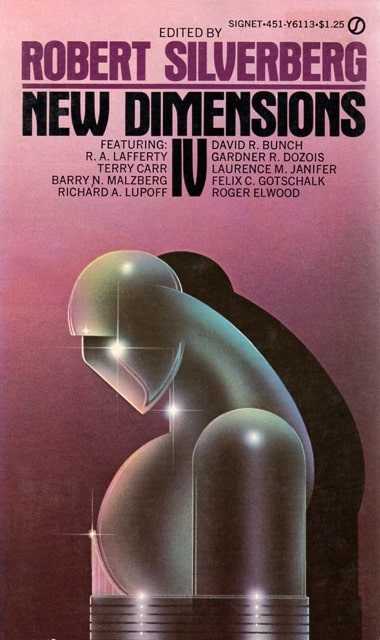
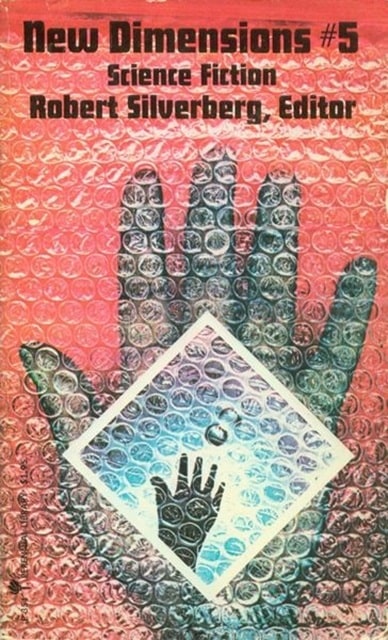
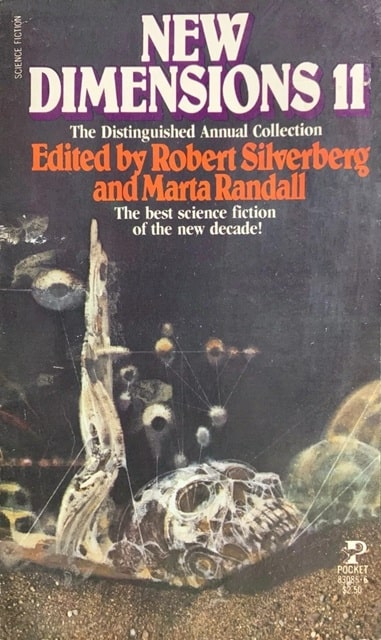
Three volumes of Robert Silverberg’s New Dimensions: IV (Signet, October 1974),
5 (Perennial Library, September 1976), and 11 (edited with Marta Randall,
Pocket Books, July 1980). Cover art: unknown, Joe Harris, Richard Powers
This anthology highlights an aspect of Silverberg’s career for which he perhaps hasn’t gotten the credit he deserves: his influence on SF as an editor and anthologist. And it is possible that the single best original anthology Robert Silverberg produced was this one — The New Atlantis. The three stories are by three of the greatest SF writers of all time, each at the absolute height of their powers. (And, as Silverberg notes in his introduction, all three of these writers came to SF fairly late.)
Silverberg’s editorial contributions go well beyond this book. His original anthology series New Dimensions is remarkable as well, featuring a great many of the best stories of its time. The massive original anthology Epoch (co-edited by Roger Elwood) was far better than its Elwood-stained reputation suggests. He produced many more original anthologies (see sidebar below).
He was also a prolific anthologist of older stories, most notably The Science Fiction Hall of Fame, Volume I, and a wonderful set of 7 books called Alpha. He published quite a few more short anthologies of older SF, and some later doorstops, both original (as with the Legends books, and Far Horizons, plus three books following on the late Terry Carr’s Universe series that he co-edited with his wife Karen Haber), and also reprint books, particularly two Arbor House collections of Great Short Stories and Great Short Novels.

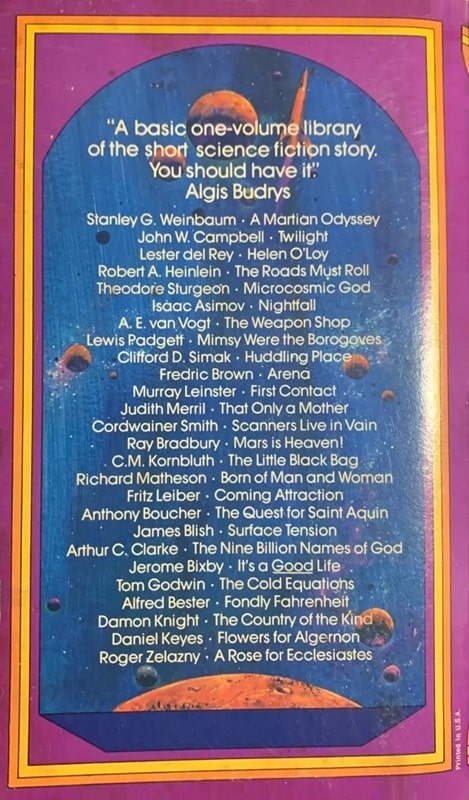
The Science Fiction Hall of Fame, Volume I, edited by Robert Silverberg (Avon, July 1971).
In the decade from 1969 to 1979, Robert Silverberg edited 11 anthologies of original novellas. (One book had four stories.) At the same time Silverberg was producing his original anthology series New Dimensions, and his reprint series Alpha. And that’s not to mention his own fiction — despite a retirement during this period he published some 15 novels and dozens of short stories.
Relatively few examples in the three novella format come from other editors. Silverberg’s primary rival (as I perceive it), Terry Carr, did just one “three novella” book, though a very good one, An Exaltation of Stars. The super prolific Roger Elwood published three, Futurelove, A World Named Cleopatra (with Poul Anderson), and In the Wake of Man. That last book, which had stories by R. A. Lafferty, and Walter F. Moudy, is one of Elwood’s very best, particularly as it features one of Gene Wolfe’s greatest novellas, “Tracking Song.”
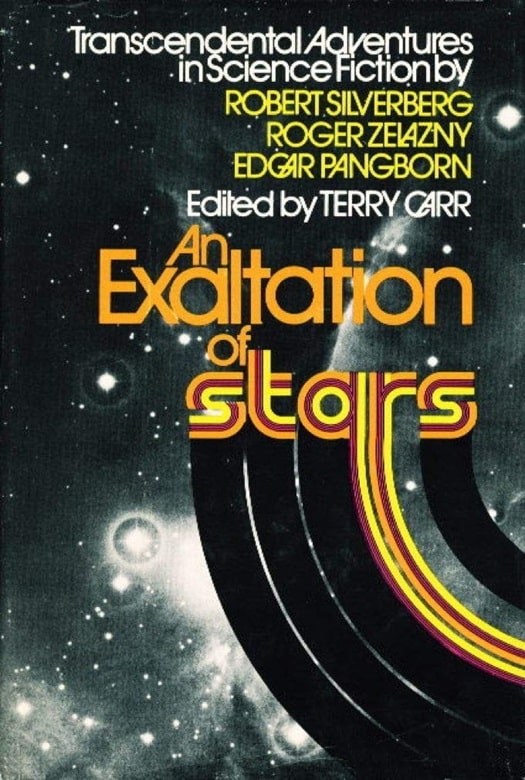
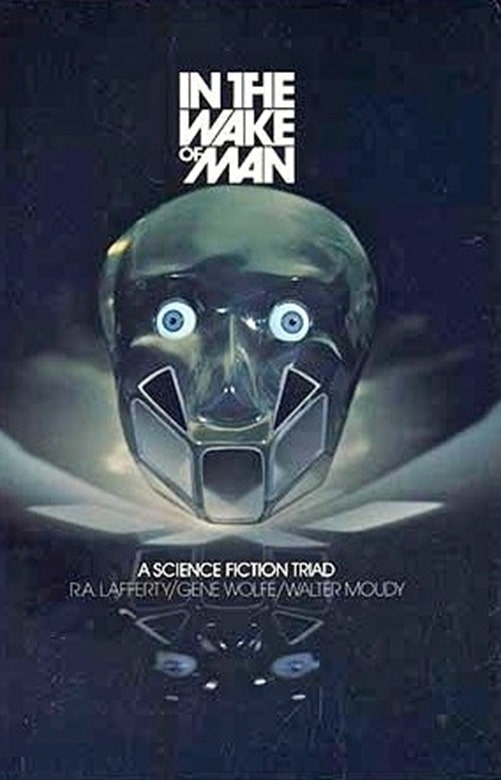
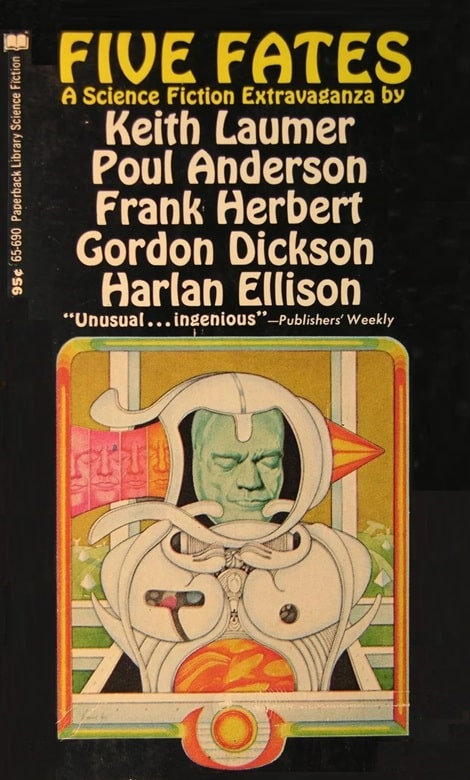
Other anthologies in a novella format: An Exaltation of Stars, edited by Terry Carr (Simon &
Schuster, June 1973), In the Wake of Man, edited by Roger Elwood (Bobbs-Merrill Company,
August 1975), and Five Fates, edited by Keith Laumer (Paperback Library, September 1971).
Cover art by Adelson & Eichinger, Nick Aristovulos, Lorraine Fox
The Anderson collaboration has four stories, all set on the title world, a creation of Anderson’s. (In this sense it mildly resembles the Twayne Triplets of the 1950s, which collected three novellas on the same subject, based on an introductory essay. Several of those books were planned, but in the end only two appeared, Witches Three and The Petrified Planet.) One other anthology of interest is a 1970 book put together by Keith Laumer, Five Fates, in which five writers continued a brief introduction by Laumer, in which a man goes to a Euthanasia center and begins to die — each writer then extrapolates what may happen to this man after (?) death.
Here are the eleven “novella” books Silverberg did.
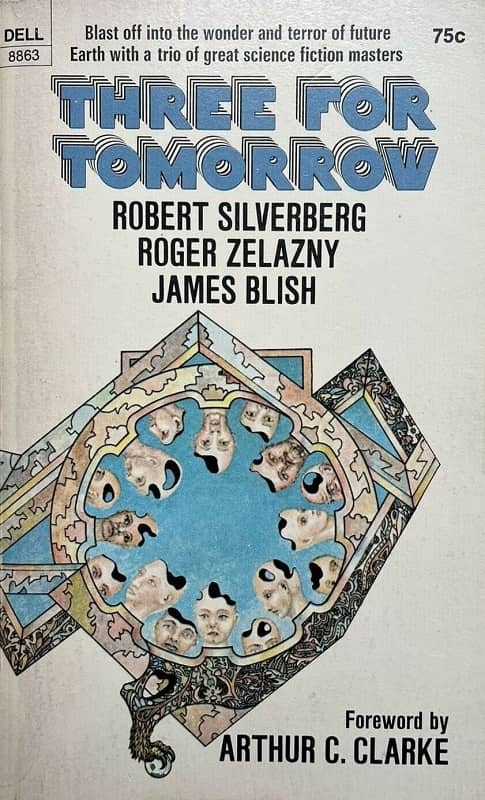
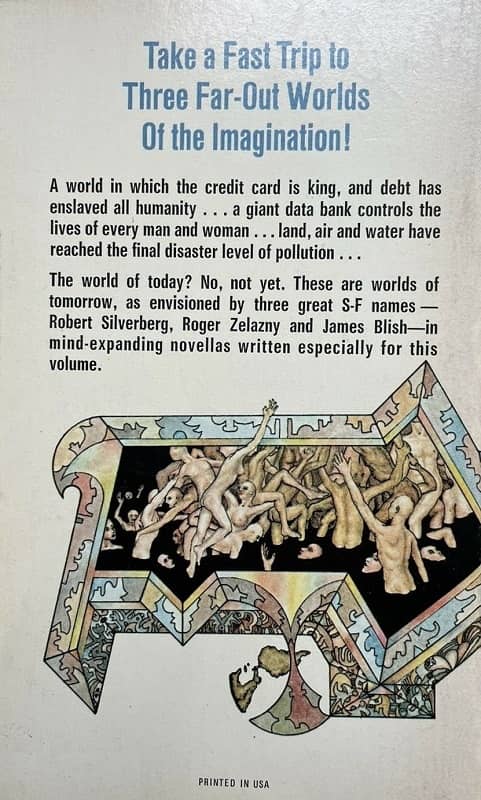
Three for Tomorrow (Dell, 1970). Cover uncredited
How It Was When the Past Went Away • novella by Robert Silverberg
The Eve of RUMOKO • novella by Roger Zelazny
We All Die Naked • novelette by James Blish
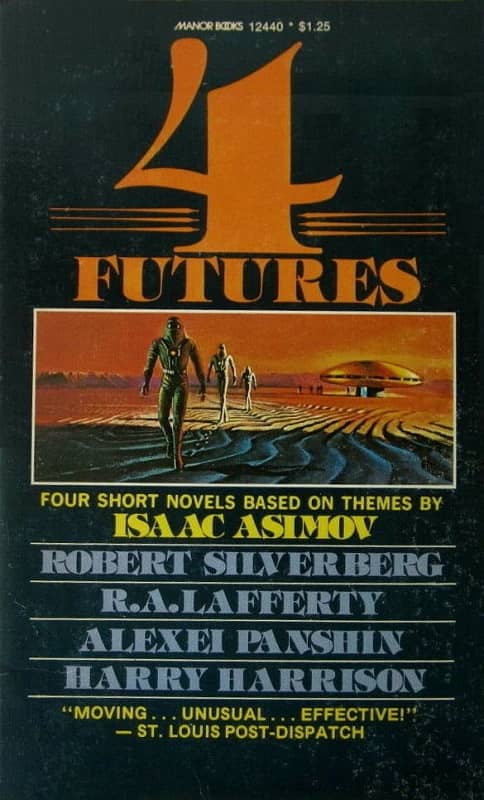
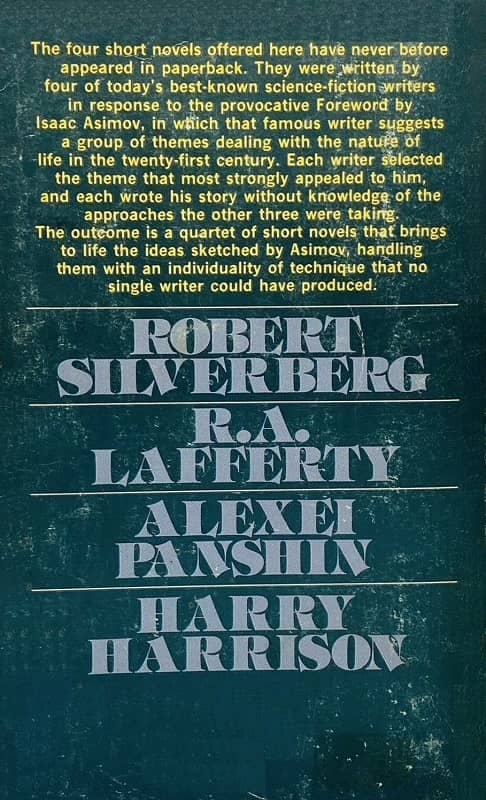
4 Futures (Manor Books, 1976 ). Cover by Bruce Pennington
Ishmael Into the Barrens • novelette by R. A. Lafferty
Brave Newer World • novelette by Harry Harrison
How Can We Sink When We Can Fly? • novelette by Alexei Panshin
Going • novella by Robert Silverberg
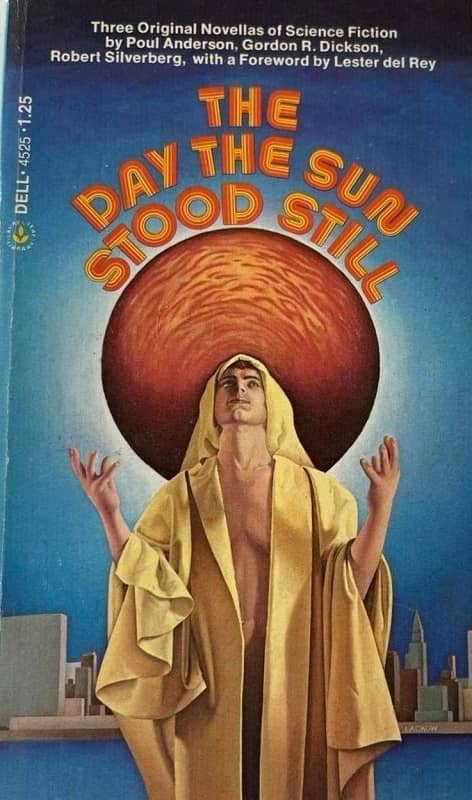
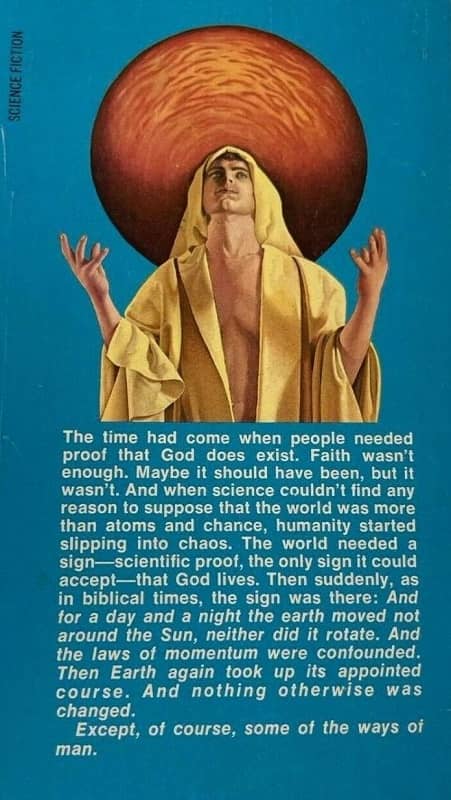
The Day the Sun Stood Still (Dell, 1975). Cover by Andy Lackow
Thomas the Proclaimer • novella by Robert Silverberg
A Chapter of Revelation • novella by Poul Anderson
Things Which Are Caesar’s • novella by Gordon R. Dickson
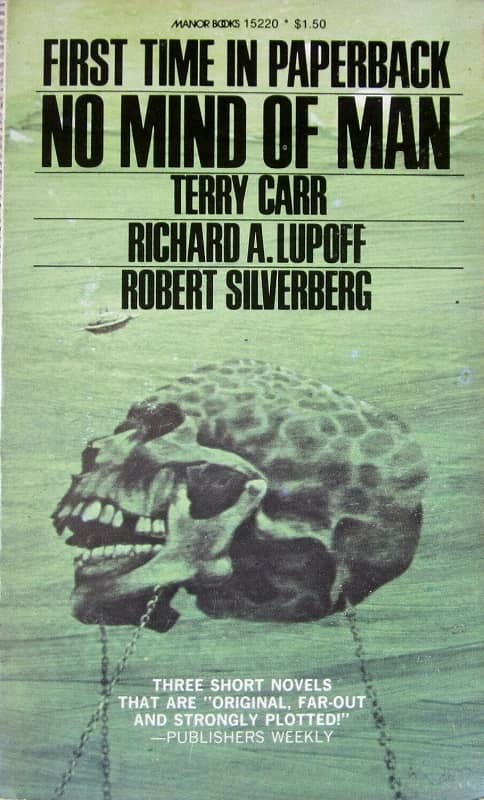
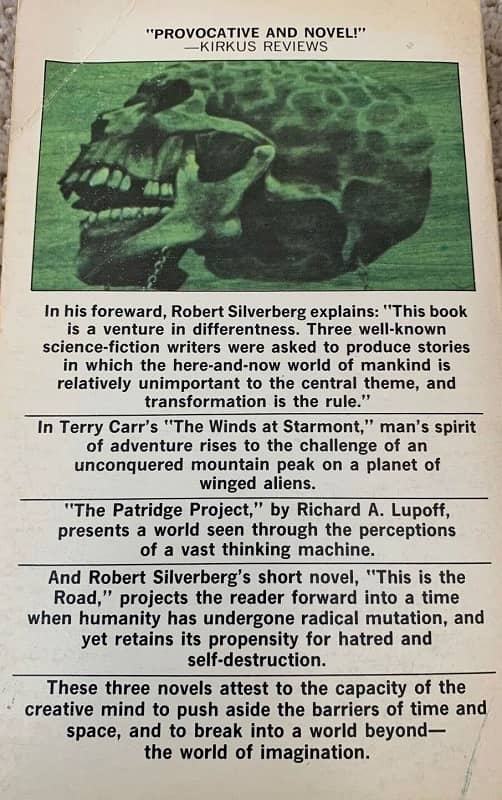
No Mind of Man (Manor Books, 1973). Cover uncredited
The Winds at Starmont • novella by Terry Carr
The Partridge Project • novella by Richard A. Lupoff
This Is the Road • novella by Robert Silverberg
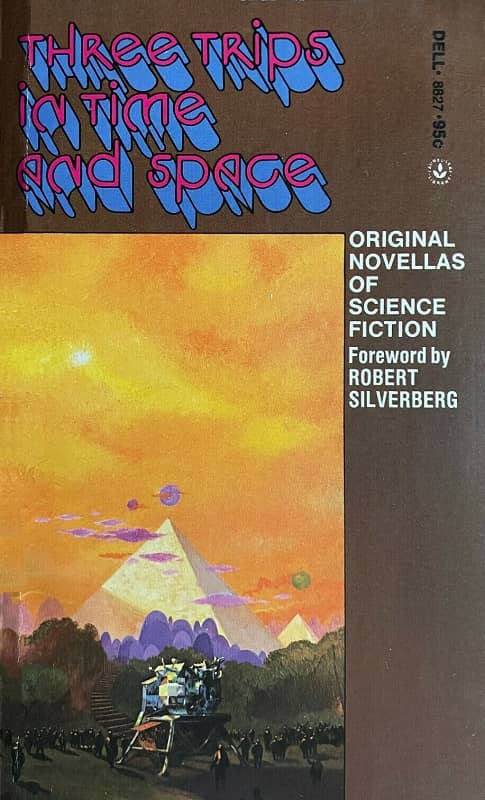
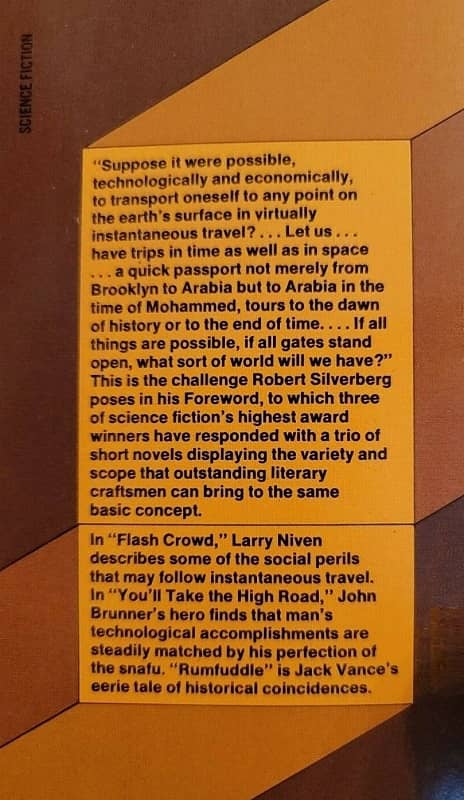
Three Trips in Time and Space (Dell, 1974). Cover by Paul Lehr
Flash Crowd • novella by Larry Niven
You’ll Take the High Road • novella by John Brunner
Rumfuddle • novella by Jack Vance
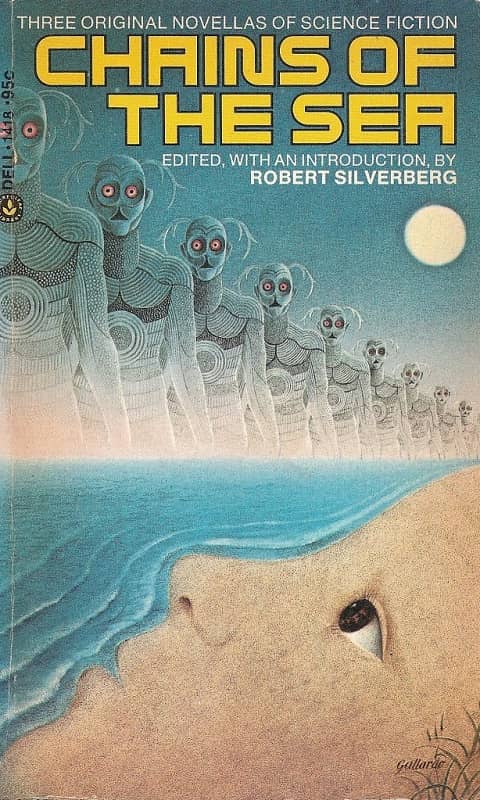
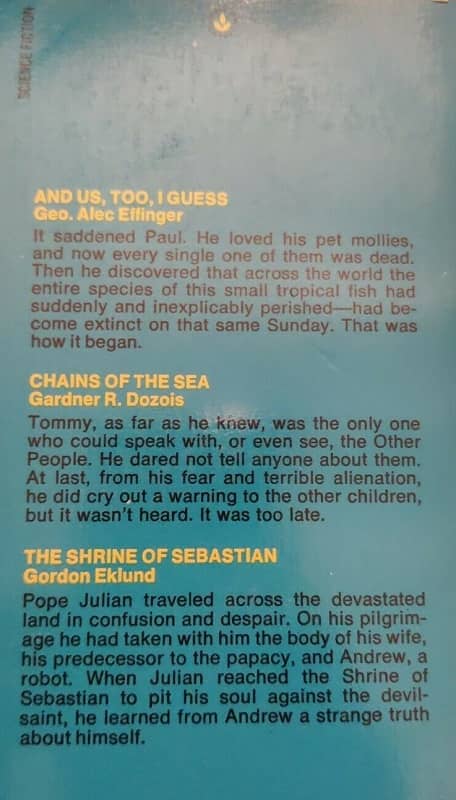
Chains of the Sea (Dell, 1974). Cover by Gervasio Gallardo
And Us, Too, I Guess • novella by George Alec Effinger
Chains of the Sea • novella by Gardner Dozois
The Shrine of Sebastian • novella by Gordon Eklund
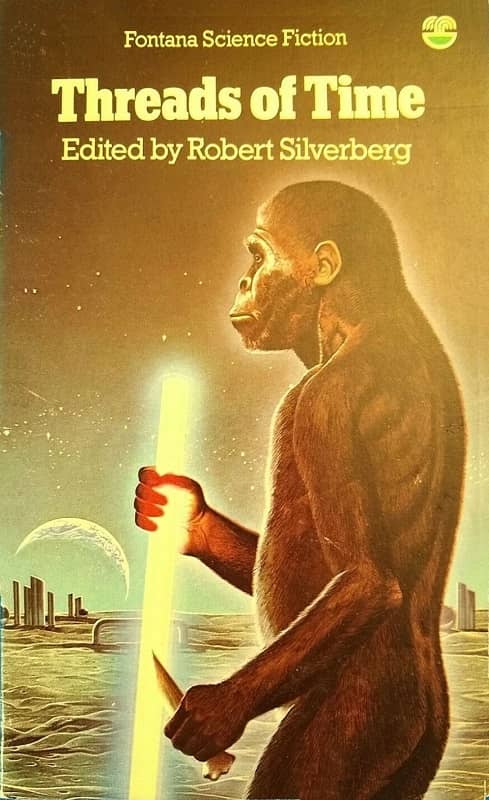
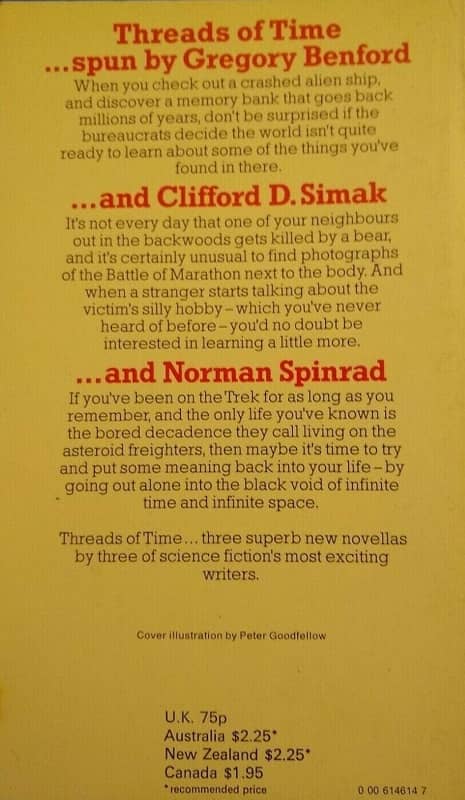
Threads of Time (Fontana, 1977). Cover by Peter Goodfellow
Threads of Time • novella by Gregory Benford
The Marathon Photograph • novella by Clifford D. Simak
Riding the Torch • novella by Norman Spinrad


The New Atlantis (Warner Books, 1978). Cover by Lou Feck
Silhouette • novella by Gene Wolfe
The New Atlantis • novelette by Ursula K. Le Guin
A Momentary Taste of Being • novella by James Tiptree, Jr.
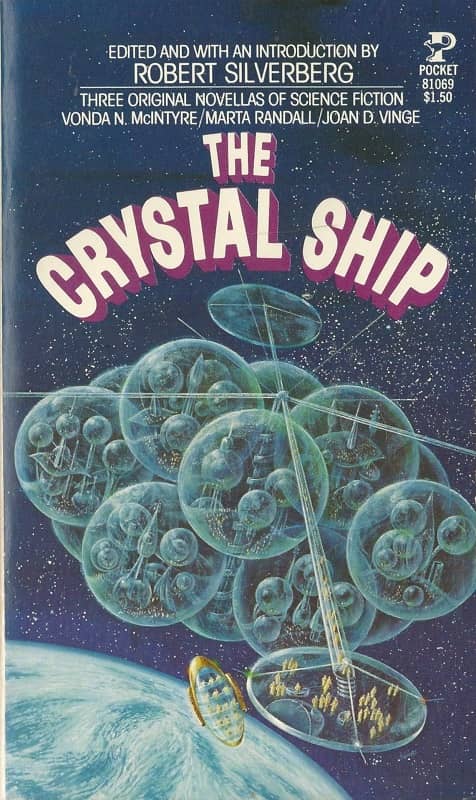
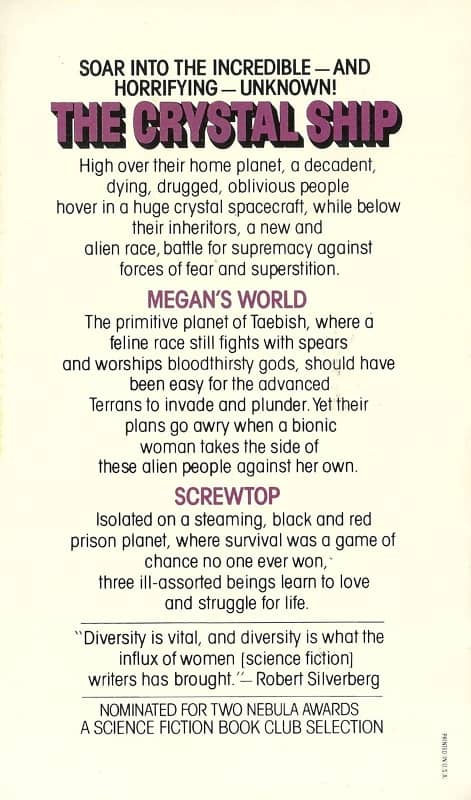
The Crystal Ship (Pocket Books, 1977). Cover byNorman Adams
The Crystal Ship • novella by Joan D. Vinge
Megan’s World • novella by Marta Randall
Screwtop • novella by Vonda N. McIntyre
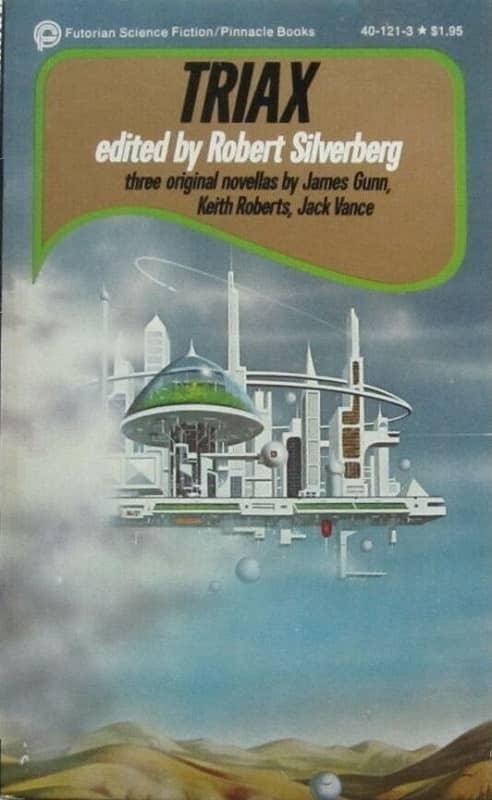
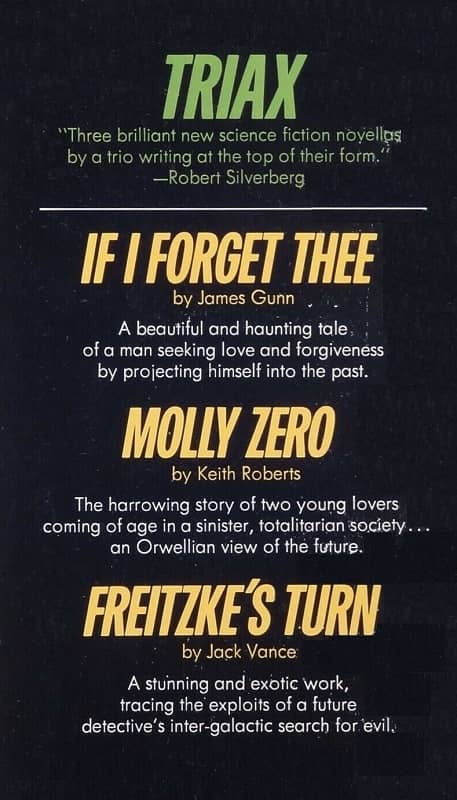
Triax (Pinnacle, 1977). Covers by Randy Weidner
Molly Zero • novella by Keith Roberts
If I Forget Thee • novella by James E. Gunn
Freitzke’s Turn • novella by Jack Vance
The Edge of Space hardcover edition (Elsevier/Nelson Books, 1979). Wraparound cover by Freff
The Edge of Space (1979)The King’s Dogs • novella by Phyllis Gotlieb
In the Blood • novella by Glenn Chang
Acts of Love • novella by Mark J. McGarry
Rich Horton’s last article for us was an obituary for Barry N. Malzberg. His website is Strange at Ecbatan. Rich has written over 200 articles for Black Gate, see them all here.

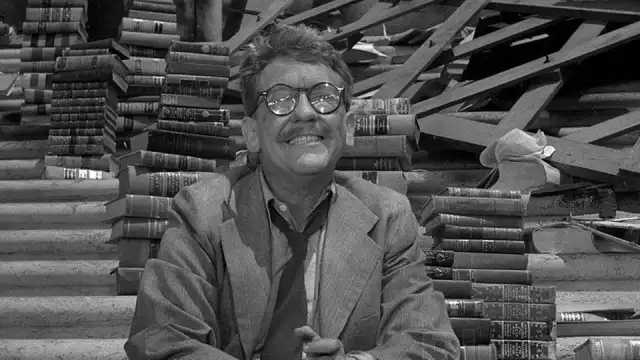
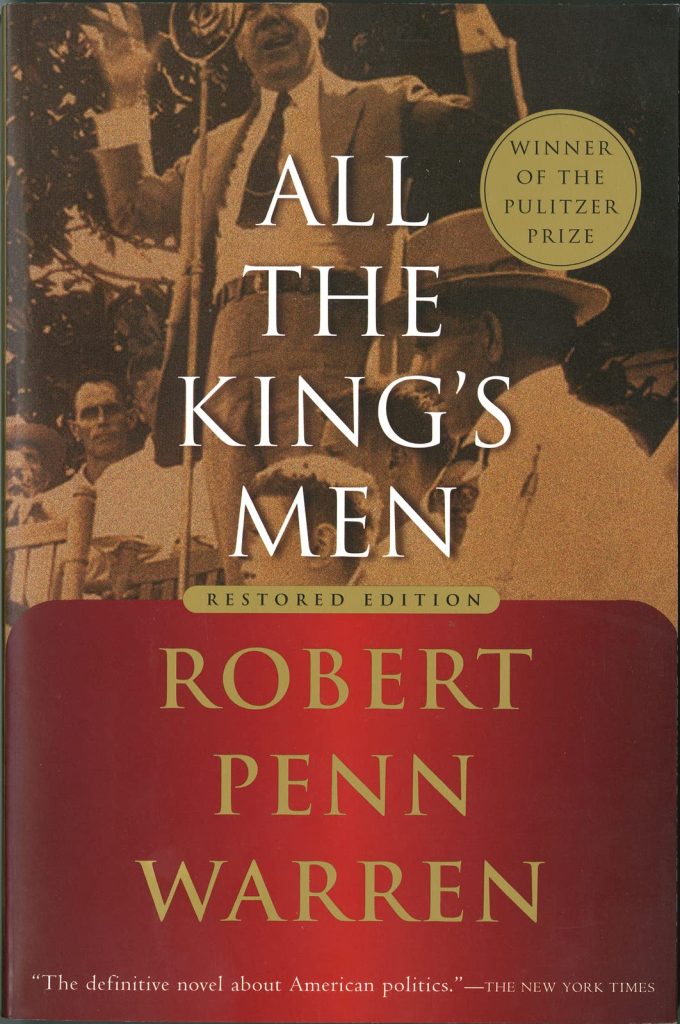
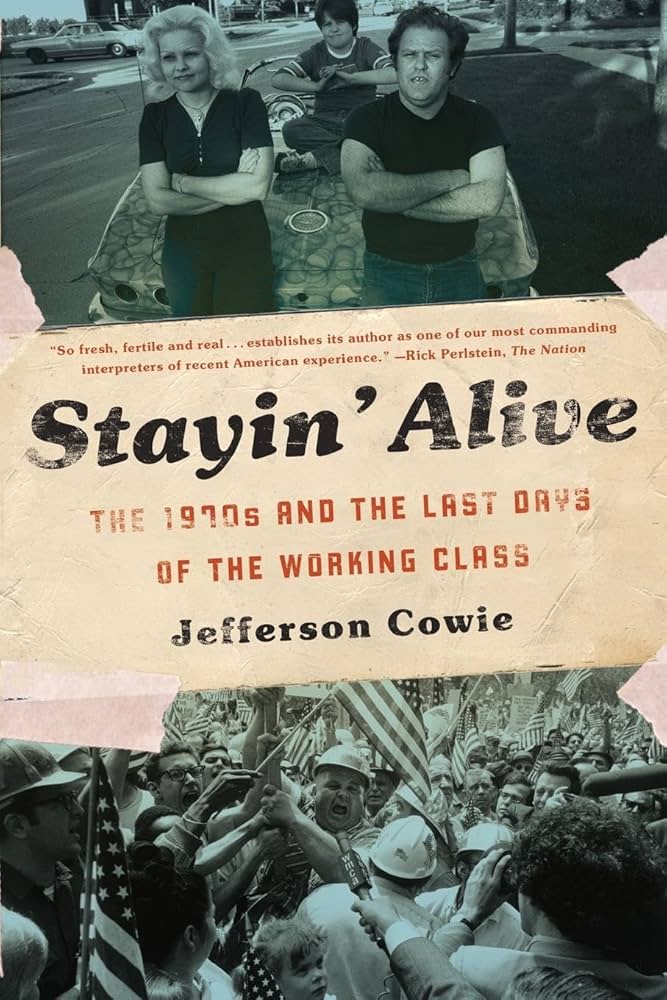
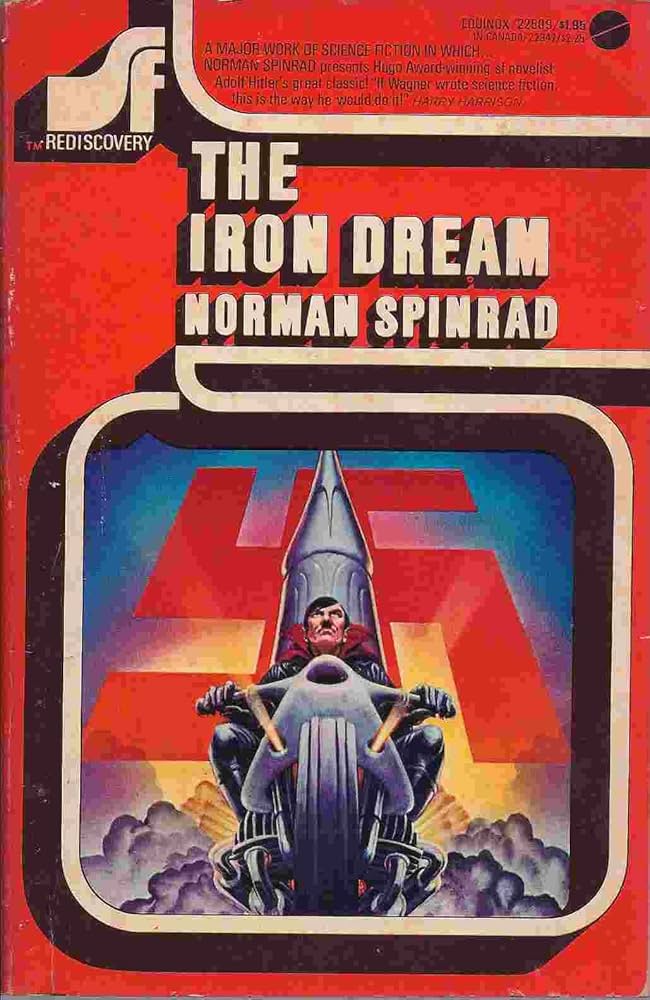

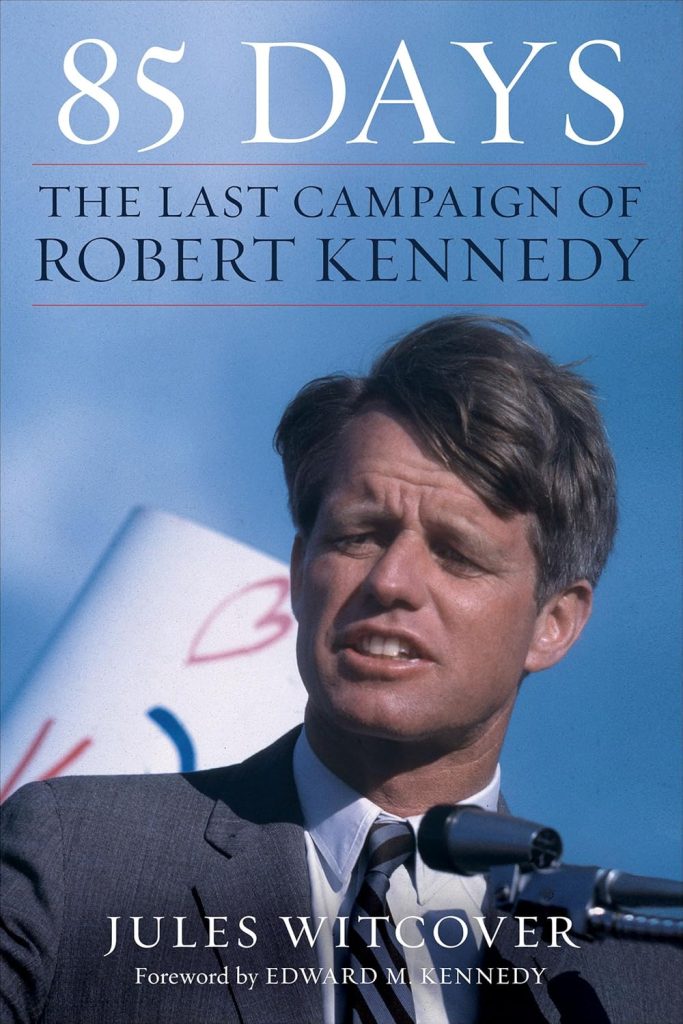

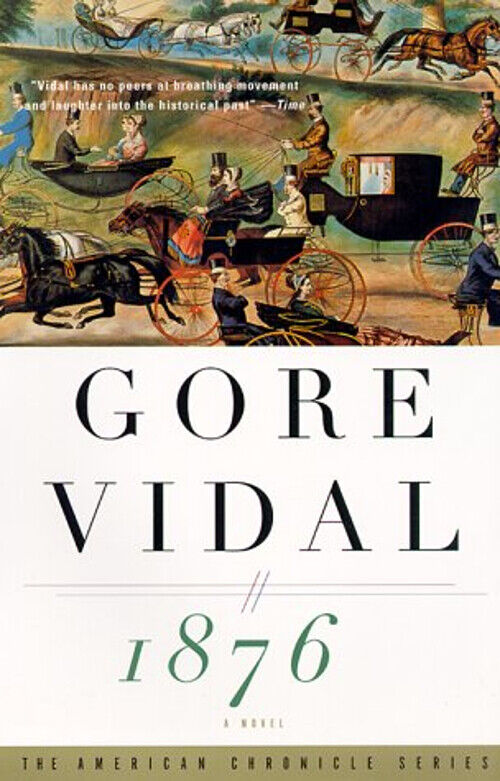
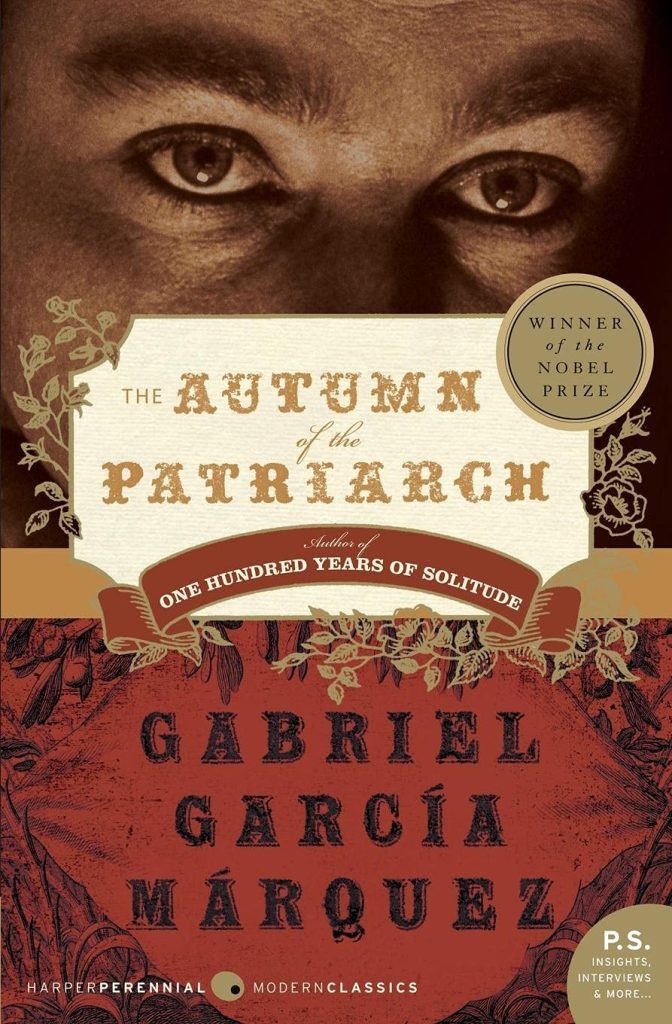
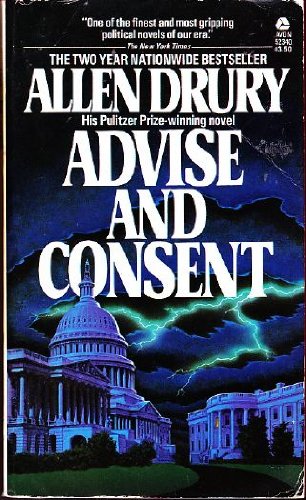
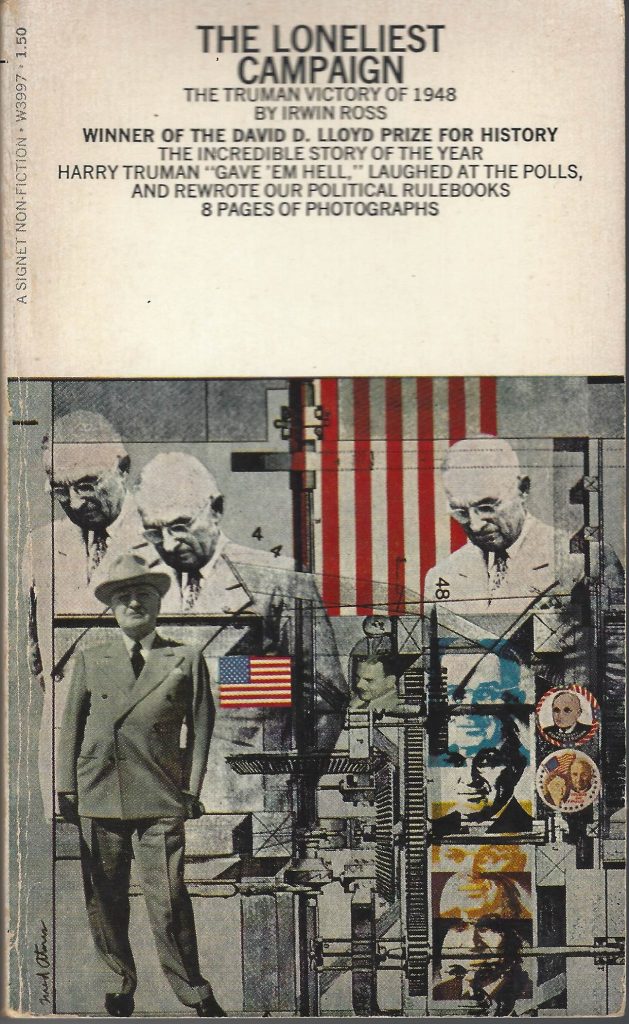
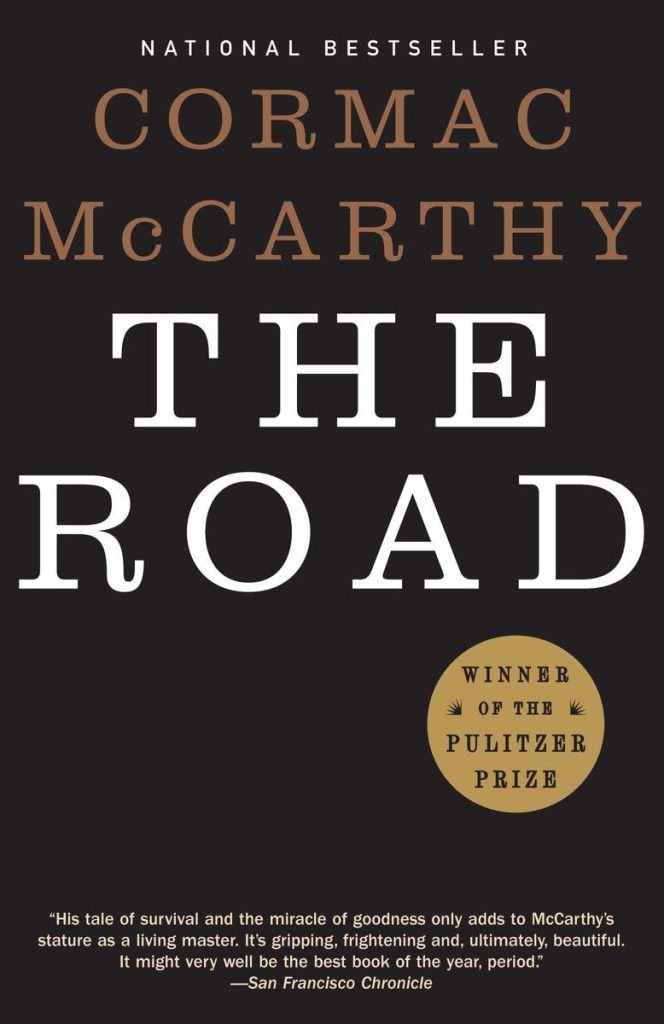


Recent comments